|
|
Post by Karl Welteke on Dec 2, 2018 18:20:58 GMT 8
Luzon Guerrilla Army Forces (LGAF), Plaque, C.O. Major Robert Lapham The story of the WWII Guerrillas in the Philippines is extra ordinary to me. Since I live in the Philippines I have looked up information about them and some of the locations of their activities. This thread is about the WWII Guerrillas in Central Luzon. I read that the Umingan Veterans established a monument with a plaque in Commemoration of the Luzon Guerrilla Army Forces (LGAF) liberating Umingan from the Japanese Aggressors. The Commander of the LGAF, Major Robert Lapham had established his Head Quarter in the Umingan area. I also asked whether the Umingan Town had any WWII Memorials or markers; the Umingan Tourist Office did not know. They showed me the 2018 Fiesta Book and I noticed it did not say anything about WWII in it, in the history section. I traveled to Umingan Town to find it and since the Tourist Office in the Umingan Town Hall did not know about it so I looked for it myself. I found it in the Umingan Plaza but it looks very much neglected. I took pictures of the neglected LGAF Monument and of some other historical monuments in the town plaza. 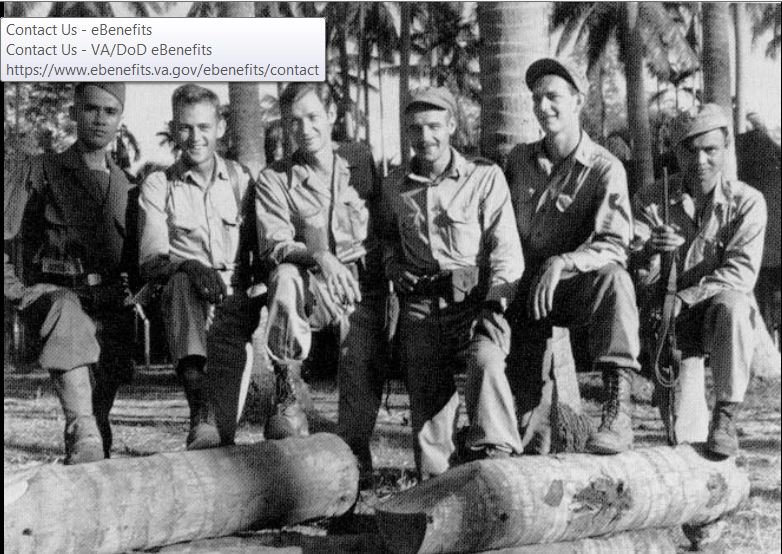 Zc950. Major Robert Lapham, 3rd fm. left, Wikipedia. The joint and combined military force of the American and Filipino soldiers under the United States Army, Philippine Commonwealth Army and Philippine Constabulary under the restoration of the Commonwealth Government was aided to fought with the recognized guerrillas on the Allied Liberation of the Philippines from the Japanese Occupation from 1944 to 1945 and including left to right: Army Lieutenant Hombre Bueno (Philippine Commonwealth Army), Army Lieutenant William Farrell (United States Army), Guerrilla Leader Major Robert Lapham (Recognized Guerrilla Unit, Luzon Guerrilla Armed Force (LGAF)), Army Lieutenant James O. Johnson (United States Army), Army Lieutenant Henry Baker (United States Army), and Guerrilla Leader Lieutenant Gofronio Copcion (Recognized Guerrilla Unit, Luzon Guerrilla Armed Force (LGAF) Johnson and Farrell were graduates of the third Alamo Scouts Training Class. Baker graduated from the seventh training class and was retained as an instructor.). 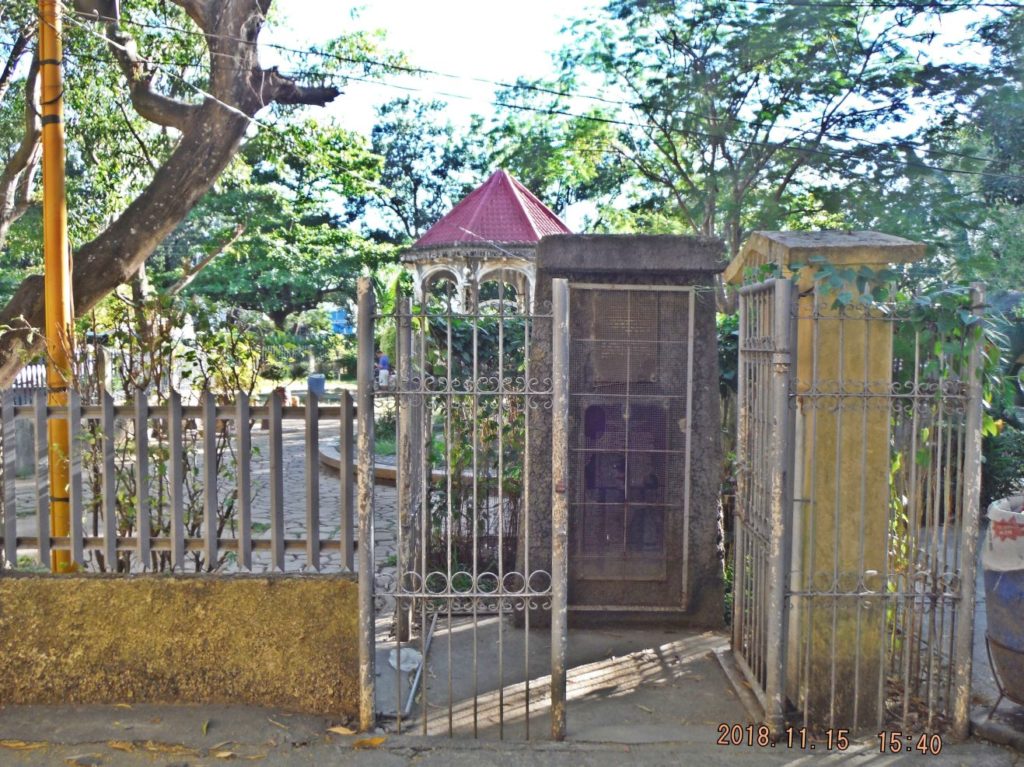 Zc951.The WWII Luzon Guerrilla Army Forces (LGAF) Memorial and Plaque in the Umingan Town Plaza; put up by the Umingan Veterans Association, honoring the Luzon Guerrillas who liberated this town from the Imperial Japanese Aggressor. Unfortunately it looks very much neglected. 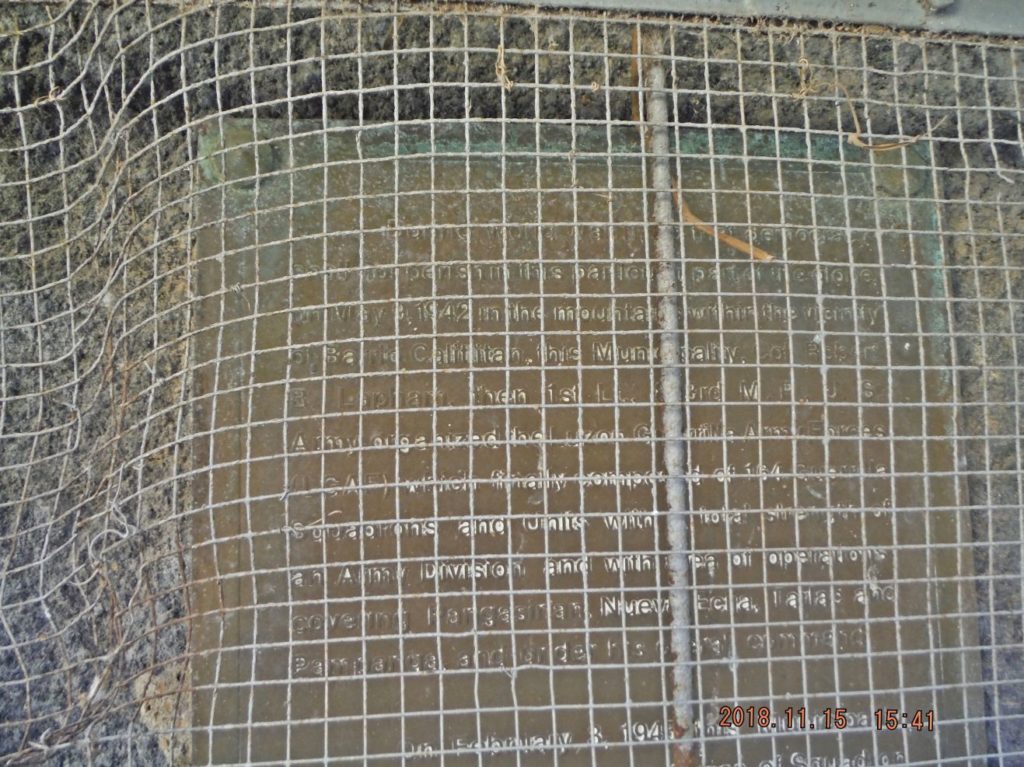 Zc952.The WWII Luzon Guerrilla Army Forces (LGAF) Plaque in the Umingan Town Plaza; put up by the Umingan Veterans Association, honoring the Luzon Guerrillas who liberated this town from the Imperial Japanese Aggressor. Unfortunately it looks very much neglected and it is very hard to read. 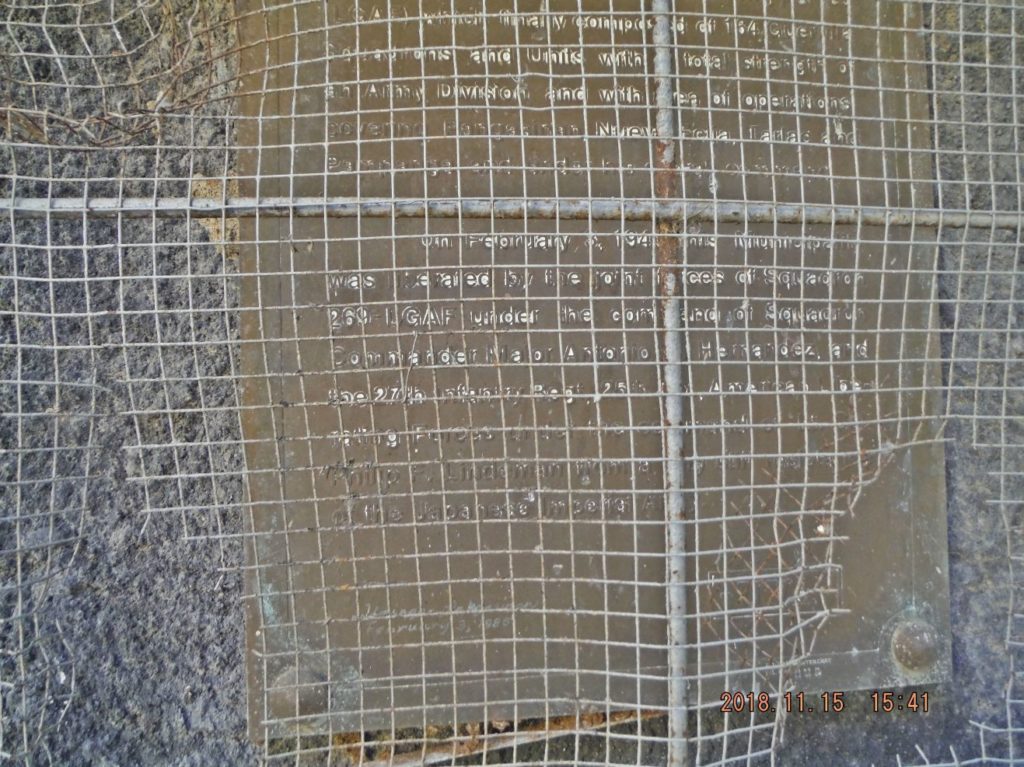 Zc953.The WWII Luzon Guerrilla Army Forces (LGAF) Plaque in the Umingan Town Plaza; put up by the Umingan Veterans Association, honoring the Luzon Guerrillas who liberated this town from the Imperial Japanese Aggressor. Unfortunately it looks very much neglected and it is damaged. 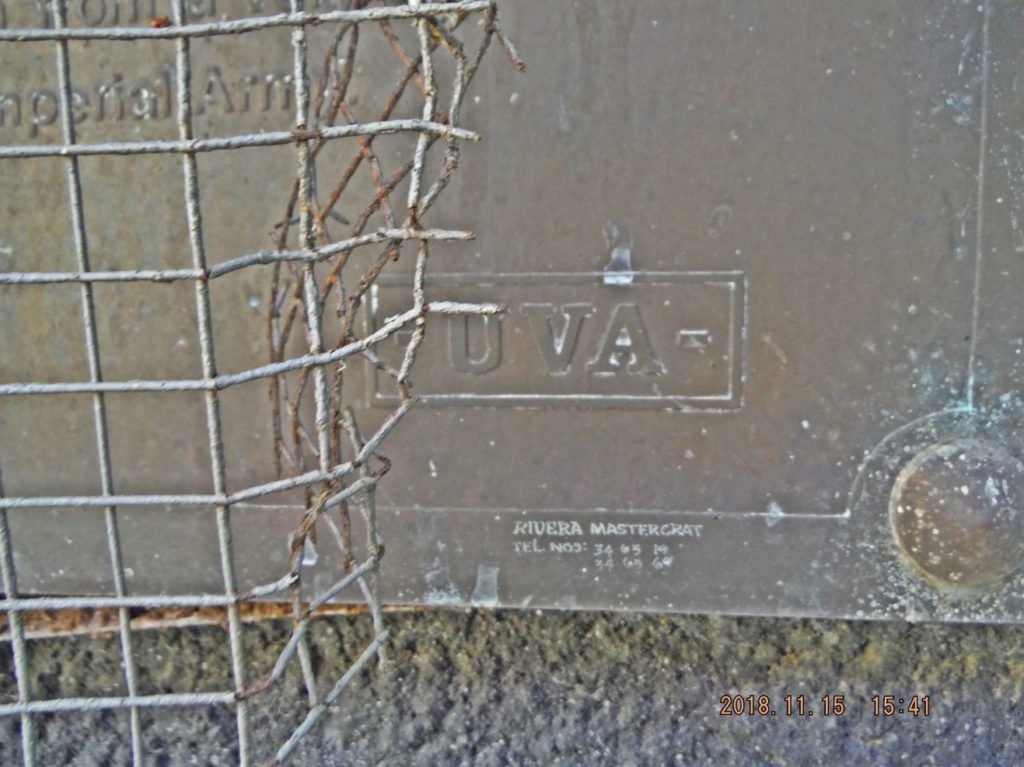 Zc954.The WWII Luzon Guerrilla Army Forces (LGAF) Plaque in the Umingan Town Plaza; put up by the Umingan Veterans Association, honoring the Luzon Guerrillas who liberated this town from the Imperial Japanese Aggressor. The Plaque has the signature of the people who erected it, it was the people of Umingan Town, the Umingan Veterans Association. Unfortunately it looks very much neglected and it is damaged. 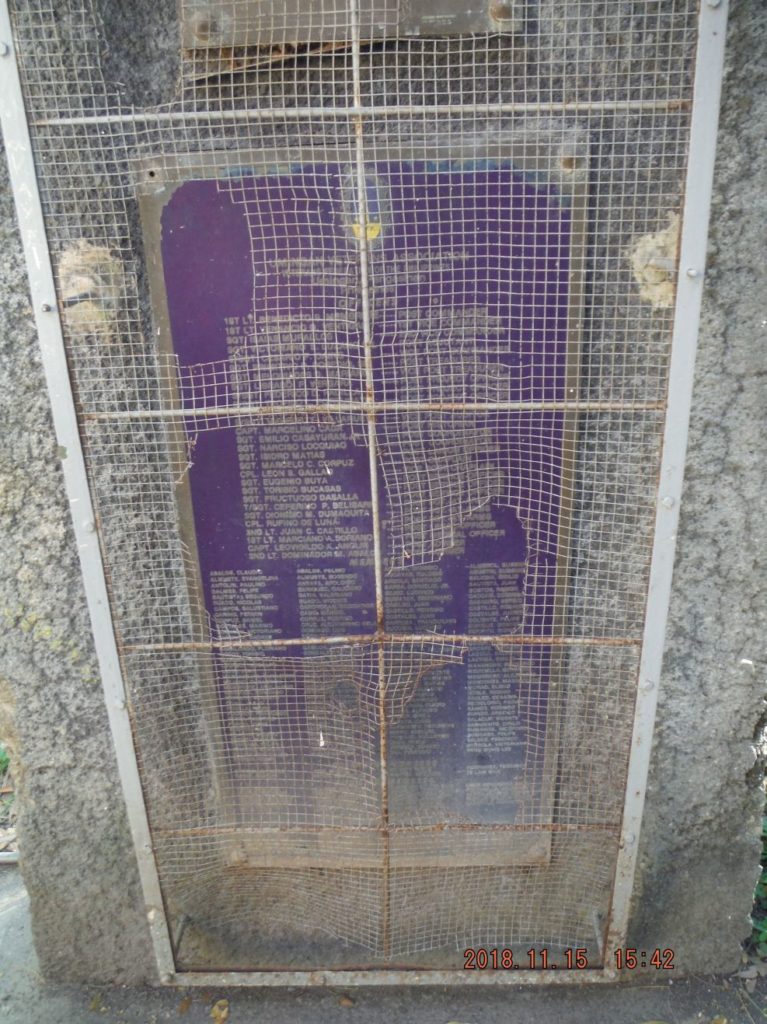 Zc955.The WWII Luzon Guerrilla Army Forces (LGAF) Plaque in the Umingan Town Plaza; put up by the Umingan Veterans Association, honoring the Luzon Guerrillas who liberated this town from the Imperial Japanese Aggressor. The lower part of the Memorial lists the names of the veterans; I’m sure many of these veterans were citizen of Umingan. Unfortunately it looks very much neglected and it is damaged. ------------------------------------------------ The LGAF Plaque in Umingan says this, I deciphered it: During WWII, so that democracy shall not perish in this particular part of the globe, on May 9, 1942 in the mountains within the vicinity of Barrio Calitlitan Col. Robert B. Lapham, then 1st Lt. 803rd M.P. U. S, Army organized the Luzon Guerrilla Army Forces (LGAF) which finally composed of 164 Guerilla Squadrons and units with a total strength of an Army Division and with area of operations covering Pangasinan, Nueva Ecija, Tarlac and Pampanga under his overall command. On Feb. 3 1945 this Municipality was liberated by the joint forces of Squadron 269 LGAF under the command of Squadron Commander Major Antonio M. Hernandez and the 27th Infantry Regt., America’s Liberating Forces under the command of Lt. Col. Philip T. Lindeman from a very stiff resistance of the Japanese Imperial Army. -UVA- Umingan Veterans Association The pictures above have been uploaded in high resolution into this Flickr album in case you want to try to decipher it yourself: www.flickr.com/photos/44567569@N00/albums/72157700770241712In the internet this chapter XI of a well known publication (Triumph in the Philippines) tells the story of the liberation of this area: www.ibiblio.org/hyperwar/USA/USA-P-Triumph/USA-P-Triumph-11.html--------------------------------------------------- 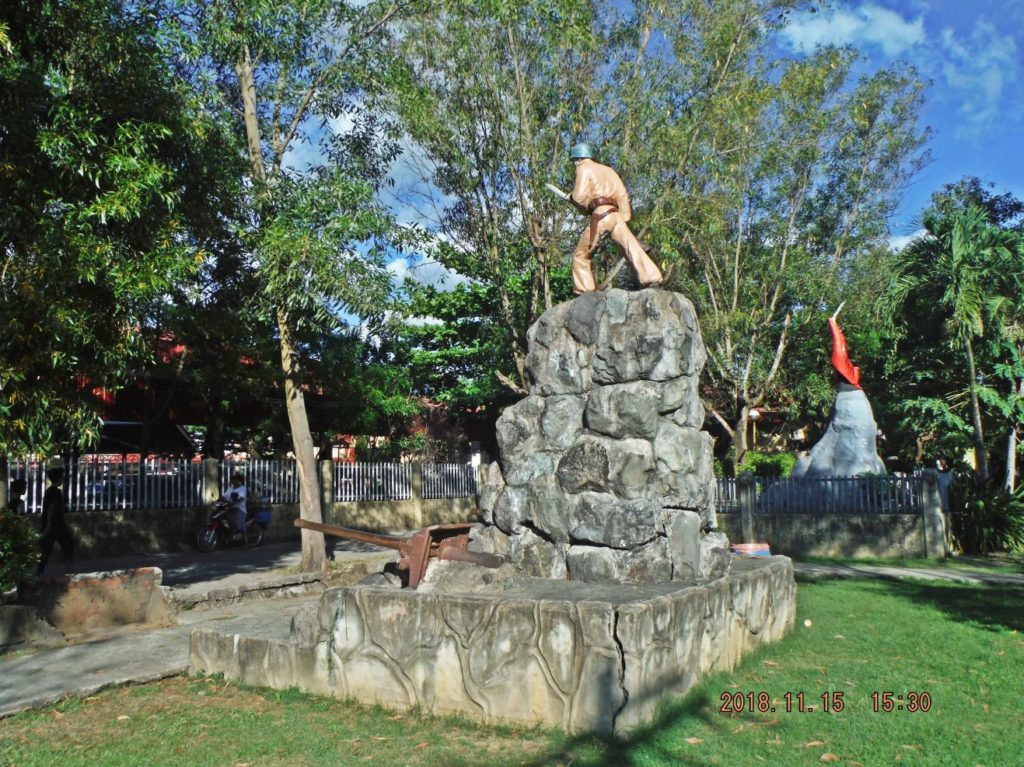 Zc956. Although the Tourist Office of the Umingan Town did not know whether the town had a WWII memorial or not, I found this Memorial. It did not have any plaque or description. The two gun barrels are interesting. Could they be from Japanese tanks or artillery? The Imperial Japanese Army had a tank division defending this area. 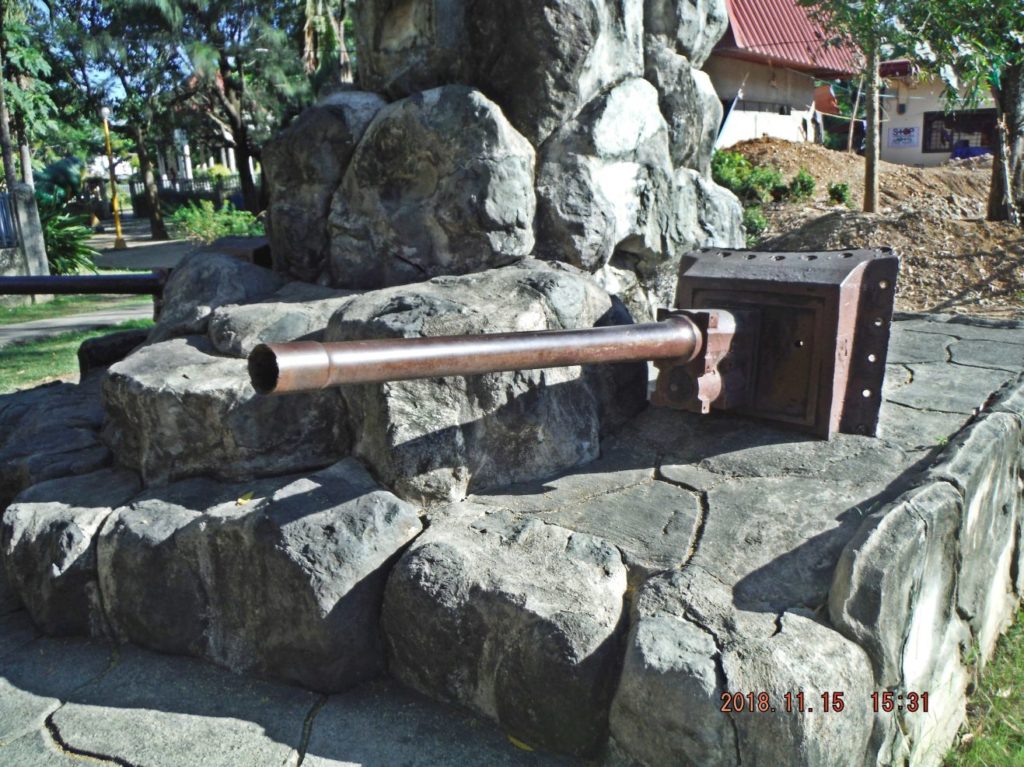 Zc957. Although the Tourist Office of the Umingan Town did not know whether the town had a WWII memorial or not, I found this Memorial. It did not have any plaque or description. The two gun barrels are interesting. Could they be from Japanese tanks or artillery? The Imperial Japanese Army had a tank division defending this area. 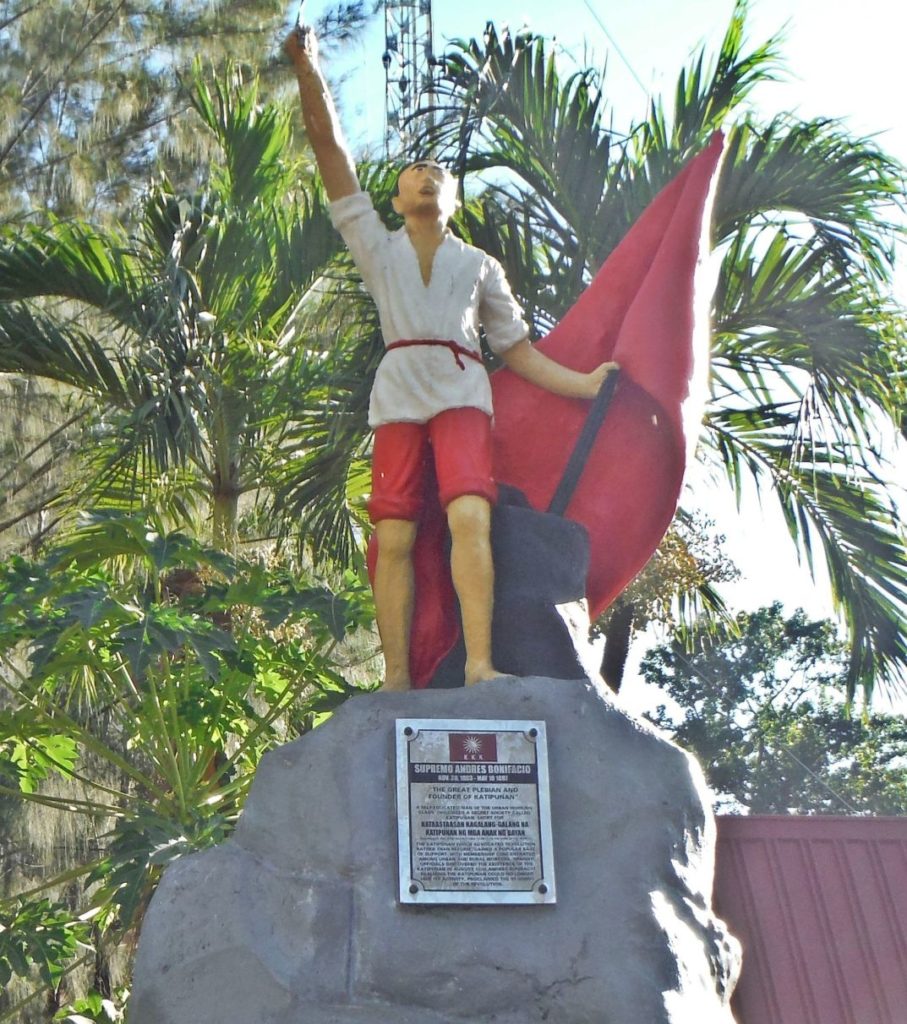 Zc958. The Umingan Town did have the customary Memorial and Statures for the heroes Andres Bonifacio and Dr. Rizal. ----------------------------------------------------- I shot a total of 27 images and they are all in this Photobucket album: app.photobucket.com/u/PI-Sailor/a/b65caf3d-ce75-4d3f-a006-fa53f39c2fd1?field=TITLE&desc=ascNote to view the Photobucket album: When the album opens, click on the first picture or the one you would like to view, then click the icon “i” and that will open the title and description of the image or images. For a Facebook presentation I only uploaded 20 images into this album: www.facebook.com/karlwilhelm.welteke/media_set?set=a.10215076842508164&type=3&jazoest=26510012169801171051191089884717172535712111811712111056711031188652809767794865538177844984831121011005286103586510011978764810150671048311898119101774911476117451087872988510666120908877739511999901081091008849727654103------------------------------------------------------------ |
|
|
|
Post by Karl Welteke on Dec 8, 2018 21:34:09 GMT 8
Lapham’s Raiders, a good book about the Philippine Guerrillas 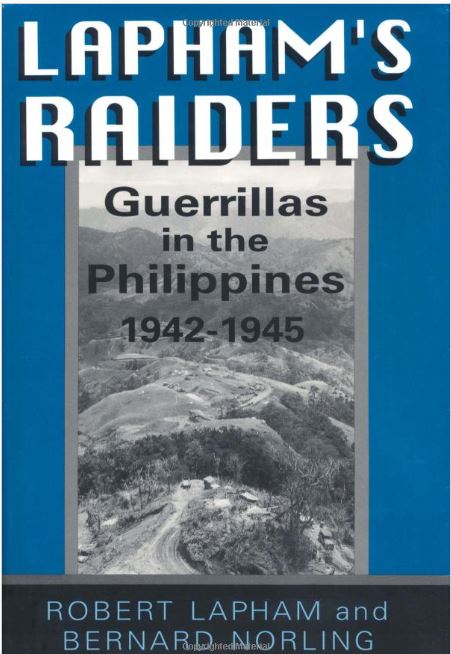 Zc972. The book cover of Lapham’s Raiders by Robert Lapham and Bernard Norling. I got the book, it is good reading he describes how it was and how his guerrillas made do. I got interested and visited Umingan, the area of his Head Quarters. The book cover picture sure reminds me of the Villa Verde Trail, the section I call: The Middle Section. Wikipedia says this about him and his Guerrillas: en.wikipedia.org/wiki/Robert_Lapham Here are some paragraphs I coppied: Robert Lapham (1917 in Davenport, Iowa – December 18, 2003 in Sun City, Arizona) was a reserve lieutenant in the US Army in World War II. He served in the Philippines attached to the 45th Infantry (Philippine Scouts),[1]:4 evaded capture in the spring of 1942, and organized a guerrilla regiment in the Central Plains of the northern island of Luzon. He was promoted to major by war's end, age 28, and was awarded the Distinguished Service Cross by General Douglas MacArthur. Lapham was the third person, after President Franklin Delano Roosevelt and MacArthur, to receive the Philippine Legion of Honor Lapham joined Major Claude A. Thorp in organizing "a raiding party that would slip through Japanese lines", sabotage Clark Field and gather intelligence for General MacArthur.On January 27, 1942, they passed through Japanese lines into the Zambales Mountains, finally reaching Mount Pinatubo, where they established Camp Four or Camp Sanchez, and the newly promoted Lieutenant Colonel Thorp established radio communication with Bataan. After the fall of Bataan, Thorp released his approximately one hundred men from following his orders, allowing them to surrender, stay or follow their own path. Lapham and Sergeants Albert Short and Esteban Lumyeb, started north, eventually making it to Lupao, Nueva Ecija, where they were joined by Sergeant Estipona and other soldiers. Lapham went on to establish another camp in Umingan, Pangasinan. By May 1942, he had a company of men in both locations, and his Luzon Guerrilla Army Force (LGAF) would dominate the northern Luzon central plain. According to Lapham, "Most of the guerrilla leaders who died in the war were killed or captured in its first year...", while the rest, "...had managed to eliminate or chase off spies and collaborators...learned how to win the support and trust of civilians...had succeeded in establishing effective spy systems of our own...had learned when to hide out and when to show ourselves..."[ Luzon Guerrilla In 1943 and 1944, the estimated 13,000 Filipinos under Lapham's command in the Luzon Guerrilla Armed Forces (LGAF), engaged in "harassing the Japanese more than they had in 1942. This included 38 squadrons in Nueva Ecija under Captain Harry McKenzie, 15 in Pangasinan under Captain Ray C. Hunt, and six in Tarlac under Captain Al Hendrickson. He also had coast watcher units at Baler Bay, Caranglan and Pantabangan, and a combat unit of southwest Pampanga under the command of Emilio and Tony Hernandez. Lapham also managed to evacuate Captain Wilbur Lage and other Americans to Australia via submarine. In mid-1944, he received radio transmitters and started sending intelligence information to Australia. This was followed by 30 tons of supplies from the USS Narwhal (SS-167) in August 1944, and another 20 tons from the USS Nautilus (SS-168) in Oct. On January 4, 1945, his forces initiated four days of sabotage in support of the Battle of Luzon. On January 8, Lapham linked up with General Walter Krueger's US 6th Army. Lapham then formed the 1st Infantry Regiment, which was attached to the 25th Division on January 20. The Japanese army put a $1 million bounty on his head. Lapham is credited for bringing the perilous situation of the 500 Allied POWs and internees remaining in the Cabanatuan POW camp to the attention of the American forces then fighting their way across Luzon towards Manila in January 1945. The POWs, captured after the fall of Corregidor and Bataan in 1942, had not been shipped to Japan because they were considered too ill or unfit. Lapham's was concerned the POWs would be executed before the camp could be liberated. His concerns were well justified given the August 1944 Japanese War Ministry directive to commandants of POW camps outlining the final disposition of prisoners (known as the "August 1 Kill-All Order") and the killing of 144 American POWs by the Japanese at Palawan, Philippines on 14 December 1944. Lapham's efforts lead to a rescue mission on January 30, 1945, by 121 members of the US Army's 6th Ranger Battalion, and two teams of Alamo Scouts, who marched 30 miles (48 km) behind enemy lines, eliminated the Japanese forces securing the camp, liberated its 513 prisoners and returned them to American lines. By May 31, 1945, Lapham had 79 squadrons, 809 officers and 13,382 men, who suffered 813 casualties |
|
|
|
Post by Karl Welteke on Dec 9, 2018 16:11:33 GMT 8
SQUADRON 269, Luzon Guerrillas Army Forces The Historical Plaque in Umingan, Pangasinan, mentions Squadron 269 and says this: On Feb. 3 1945 this Municipality was liberated by the joint forces of Squadron 269 LGAF under the command of Squadron Commander Major Antonio M. Hernandez and the 27th Infantry Regt., America’s Liberating Forces under the command of Lt. Col. Philip T. Lindeman from a very stiff resistance of the Japanese Imperial Army. Somewhere in this forum, our friend Chad told us about the Philippine Veterans Affairs Office (PVAO); that the PVAO has tons of material about WWII. This is the URL: collections.pvao.mil.ph/The PVAO states this on their web page: Philippine Archives Collection The Philippine Archives Collection is a group of records at the US National Archives that constitutes an invaluable source of information on the Pacific war, particularly concerning the treatment of prisoners of war (POWs); military operations in the Philippines, 1941-1942; guerrilla warfare in the Philippines; and conditions in the Philippines under Japanese occupation. The Guerrilla Recognition Files which is part of the Philippine Collection was digitized, brought back to the Philippines and is named the Brigadier-General Francisco Licuanan, Jr. Collection. It tells you how to search and for this purpose I just goggled for Squadron 269 LGAF and got this URL: collections.pvao.mil.ph/Guerilla/GuerillaInformationDownload/GUA-0000404#prettyPhotoI got this file: Guerrilla Unit Recognition Files 1942-48. Squadron 269, Luzon Guerrilla Army Forces (LGAF) Then you can download individual files or the whole thing, I downloaded the whole file and share only 12 files in this forum as a sample as to what is available in the PCAO Files: 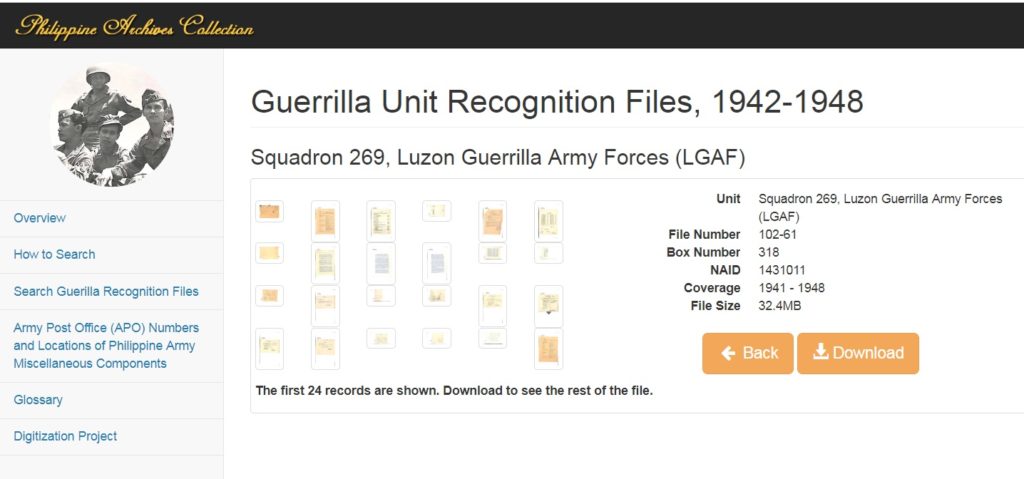 Zc973. This is the PVAO home page for the Squadron 269 of the LGAF; notice the Download button at the right lower corner. 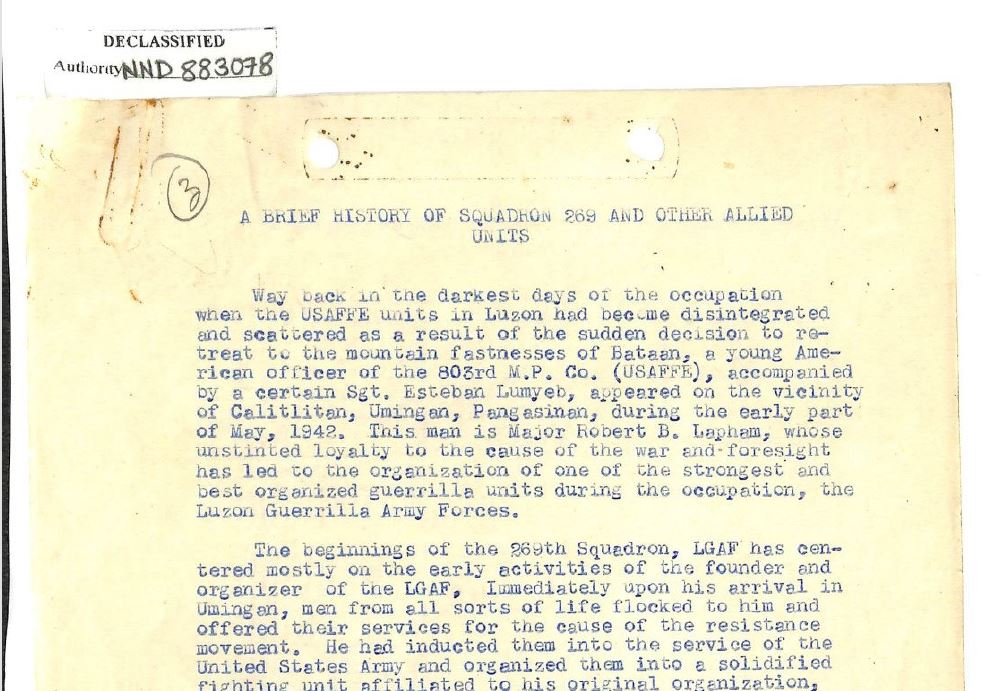 Zc974. A brief history of Squadron 269 of the LGAF and other Allied Forces. When you download the whole file at page #105 is this brief history. It is several pages long but for this purpose I only present the upper portion of the first page of this short brief history section. 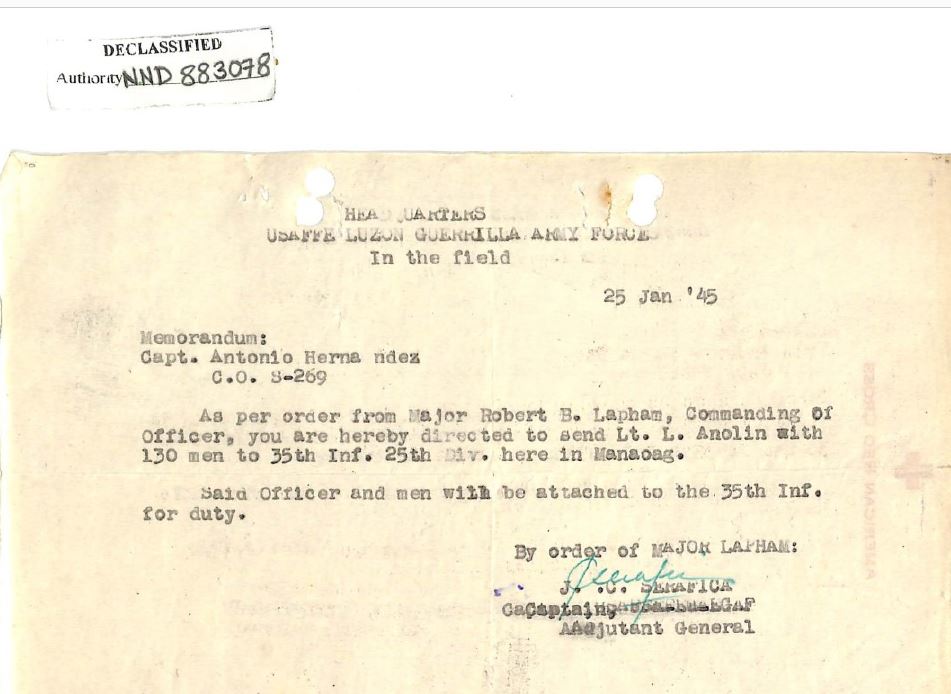 Zc975. An order by Major Lapham from Capt. Antonio Hernandez to Lt. L. Anolin with 130 men of Squadron 269 to report to the 25th Inf. Div U.S. Army. This division and the attached LGAF soldiers broke thru the Balete Pass and opened the way into the Cagayan Valley. 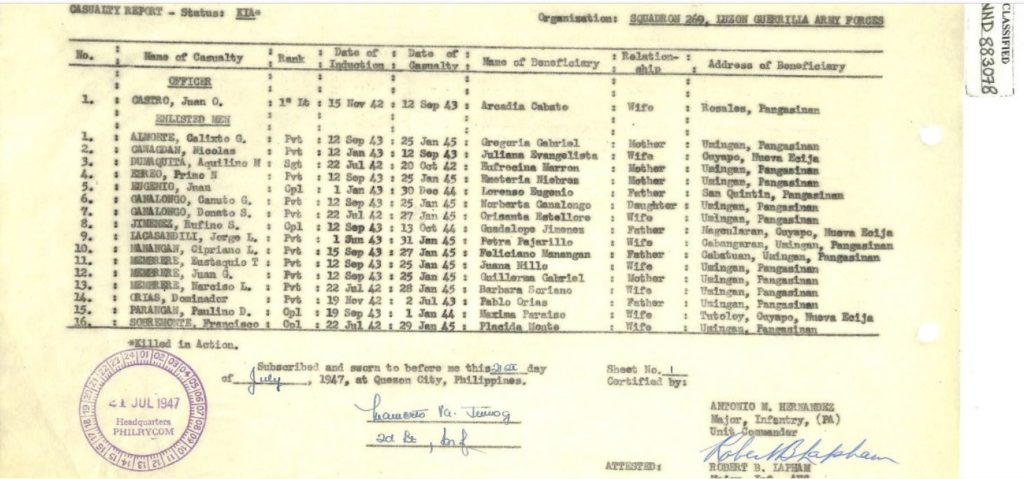 Zc976. This is only part of the Squadron 260 LGAF casualty list; I chose it because it lists 10 soldiers from the town of Umingan. When I think of these soldiers who fell for freedom of their country and then look at the dilapidated state of the LGAF Plaque in the Umingan Town Square, I feel so sad that the descendents of these soldiers seem to have forgotten their ancestors. 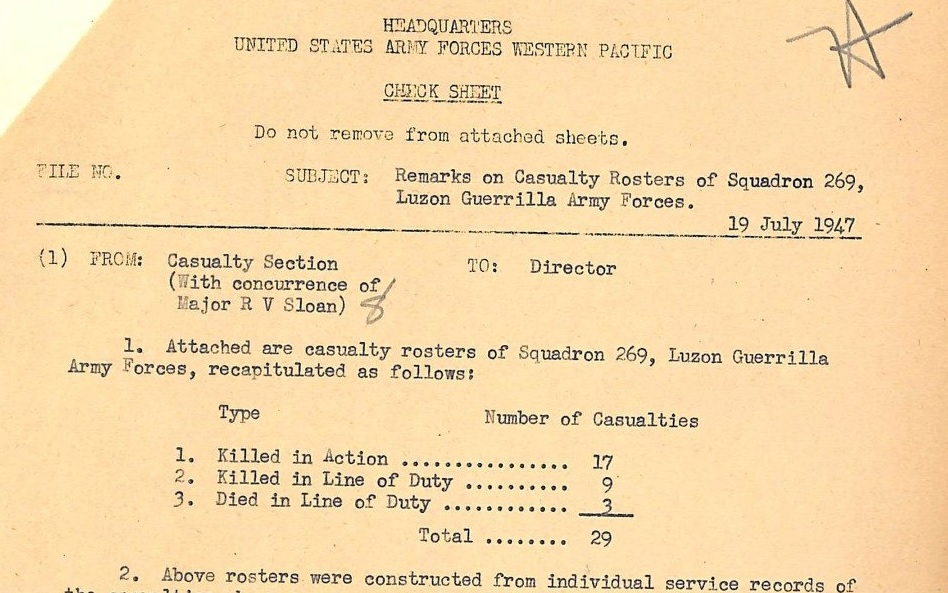 Zc977. Part 1 of 2 Casual Roster of Squadron 269 LGAF with a total of 29 casualties 19th July 1947 dated 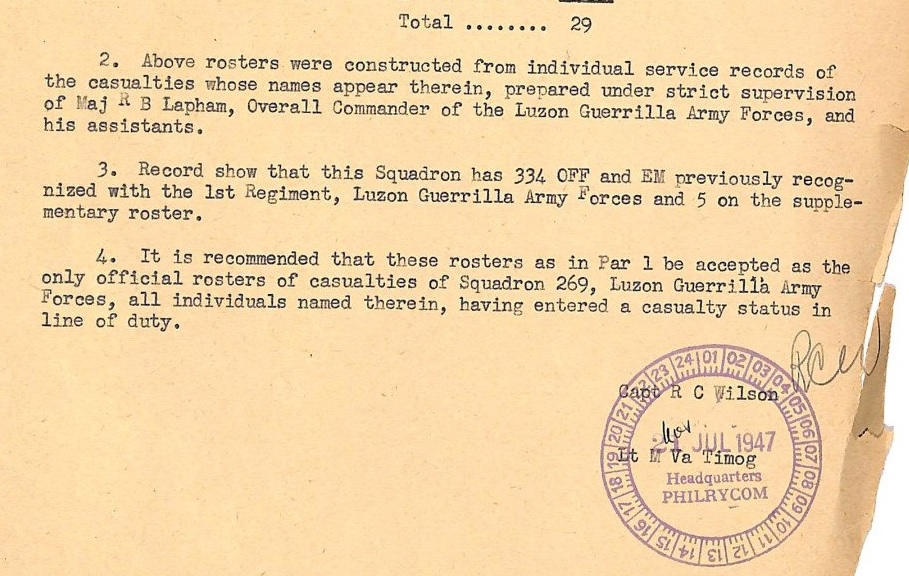 Zc978. Part 2 of 2 Casual Roster of Squadron 269 LGAF with a total of 29 casualties 19th July 1947 dated 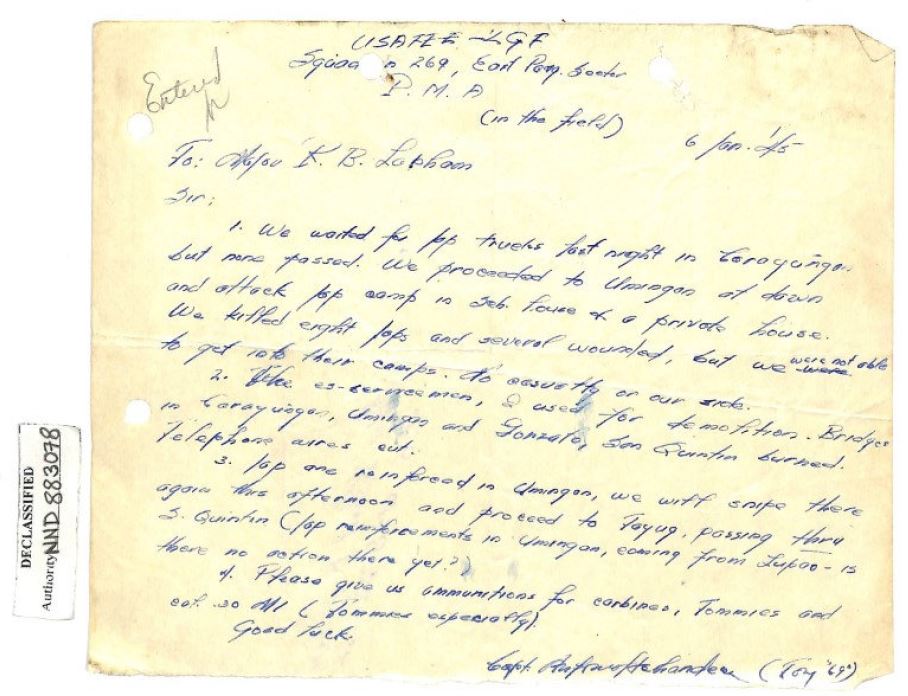 Zc979.This is an action report from Capt. Antonio Hernandez to Major Lapham dated 6th Jan.1945. The Guerrillas in this area received orders from Gen MacArthur’s Head Quarters to start a general attacks on the 4th Jan. 1945 in preparation to the Allied Landing on Luzon on the 9th of Jan. 1945. 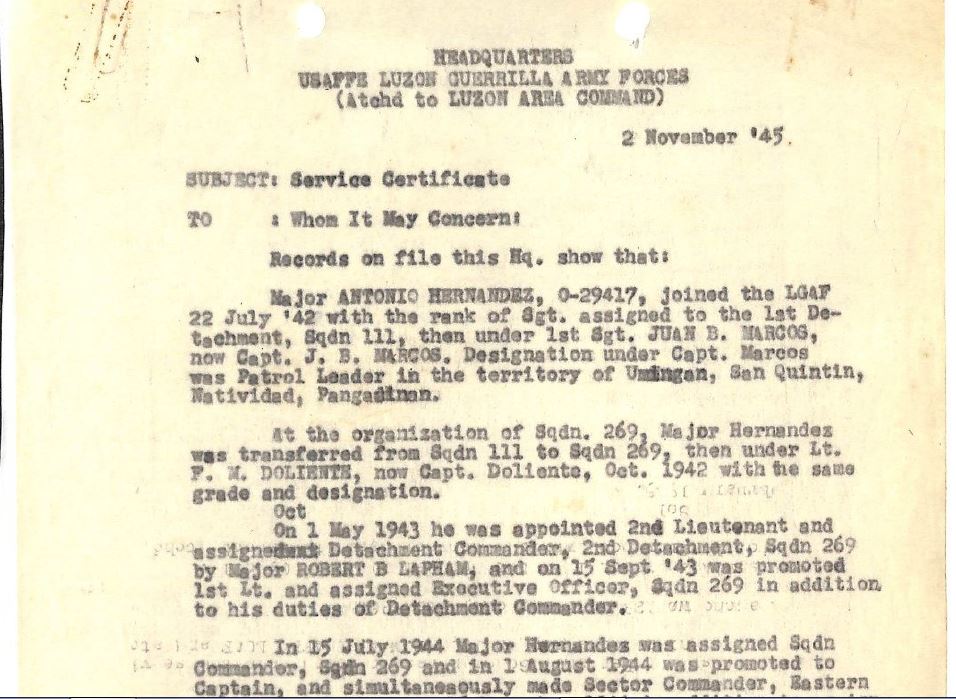 Zc980. Page 1 of a Service Certificate for Major Antonio Hernandez dated 2nd Nov. 1945 from the Headquarters, USAFFE Luzon Guerrillas Army Forces, attached to the U.S. Army Luzon Area Command. 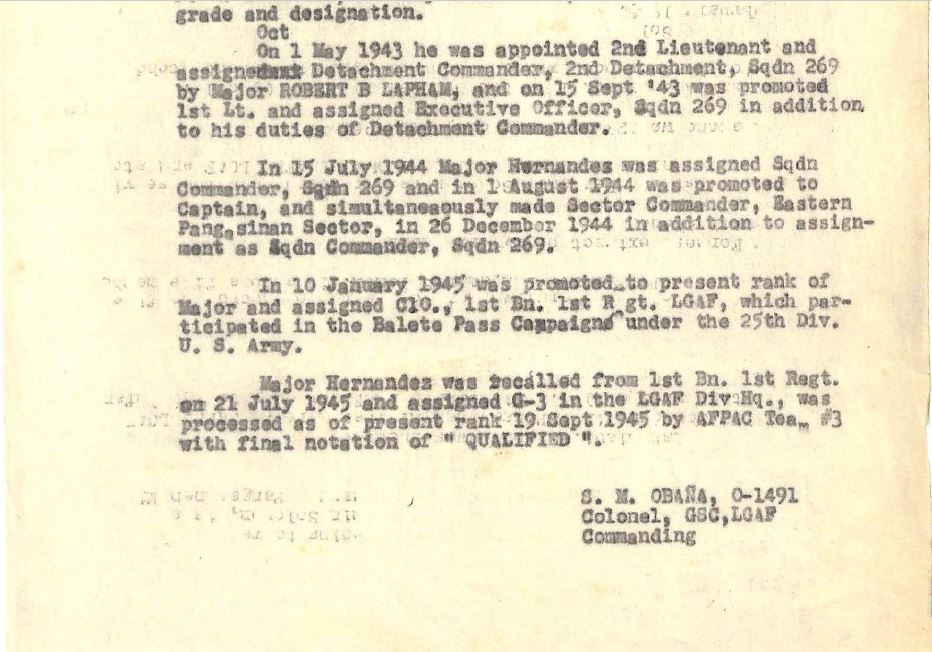 Zc981. Page 1 of a Service Certificate for Major Antonio Hernandez dated 2nd Nov. 1945 from the Headquarters, USAFFE Luzon Guerrillas Army Forces, attached to the U.S. Army Luzon Area Command. 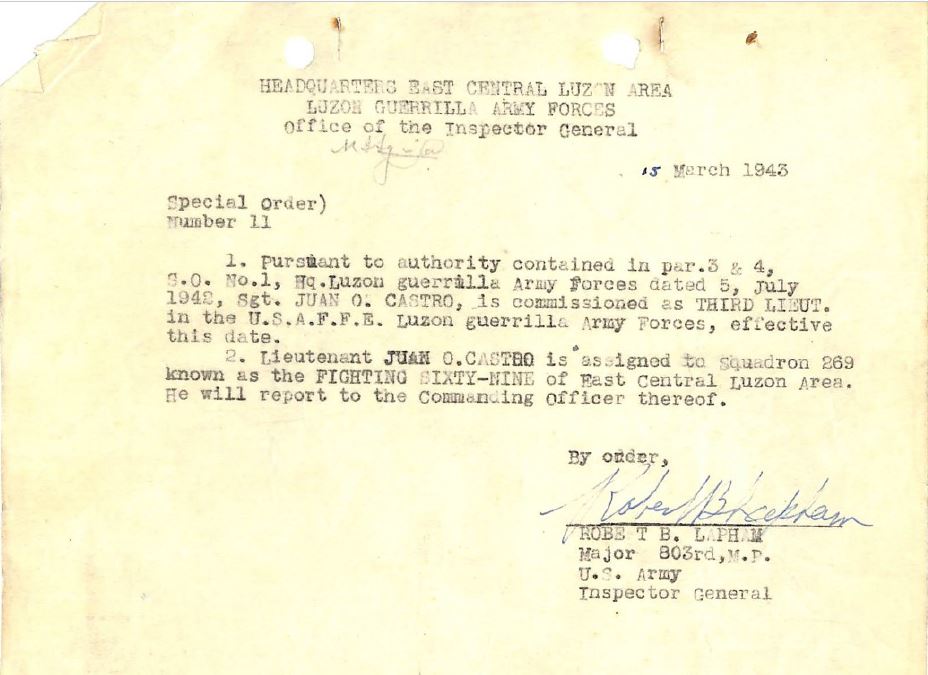 Zc982.Special Order of the Commissioning of Sgt Juan O. Castro to 3rd Lt. in the Luzon Guerrilla Army Forces by Major Lapham, dated 15th March 1943. 3rd Lt. Castro is assigned the Fighting 269. Major Lapham was part of the 803 MPs before the surrender in the Philippines in May 1942. Lt. Col. Thorp, in reorganization of the Guerrilla Forces on Luzon, appointed him as Inspector General. 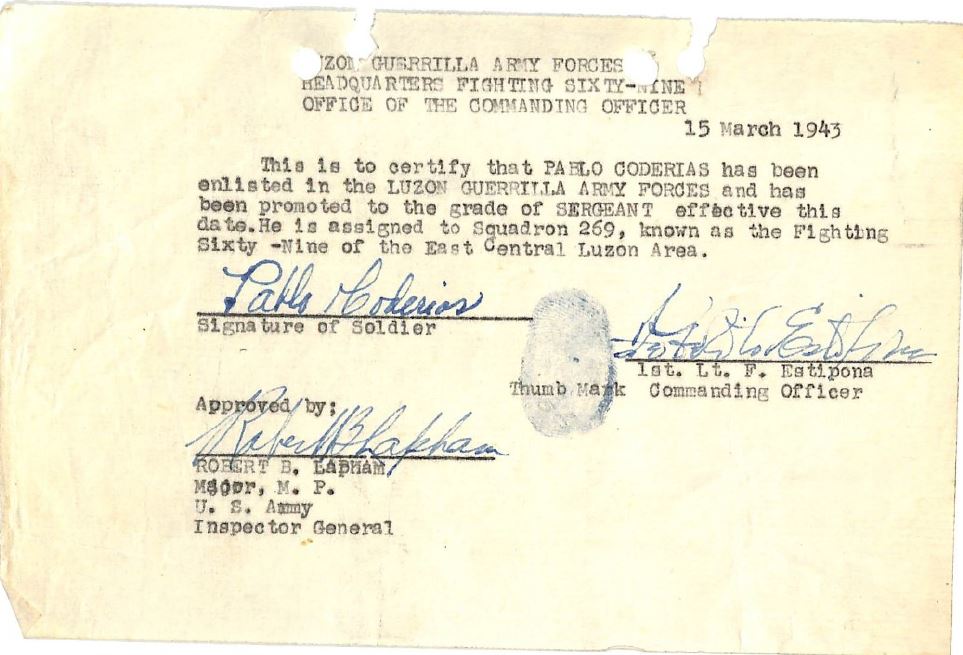 Zc983. Certification of service in the Fighting 269 and advancement to Sgt. of Pablo Corderias, dated 15th of March 1943 and is signed by Major Lapham. 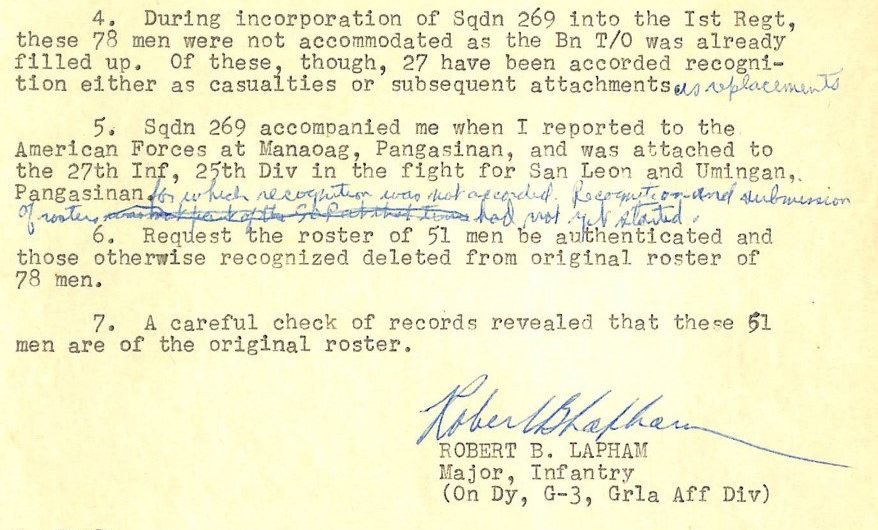 Zc984. This is part of document certifying who served as guerrillas in the Philippines and is signed by Major Lapham. After the fighting many of the surviving guerrilla leaders had to help the U.S. Authority to certify who deserved to be recognized as guerillas. This is a sample of those efforts. |
|
|
|
Post by Karl Welteke on Jan 21, 2019 19:09:19 GMT 8
Luzon Guerrilla Army Forces (LGAF) HQ Area 2018-11-15 On 2018-11-15 I took a trip to East Pangasinan to get a feel of the Luzon Guerrilla Army Forces (LGAF) Head Quarter Area. Reading about this most interesting story about resistance to aggression, the love for Freedom and Democracy I wanted to see the area in person so that I remember the story better. These pictures are about that visit. A Plaque at the Umingan says this about the LGAF: During WWII, so that democracy shall not perish in this particular part of the globe, on May 9, 1942 in the mountains within the vicinity of Barrio Calitlitan Col. Robert B. Lapham, then 1st Lt. 803rd M.P. U. S, Army organized the Luzon Guerrilla Army Forces (LGAF) which finally composed of 164 Guerilla Squadrons and units with a total strength of an Army Division and with area of operations covering Pangasinan, Nueva Ecija, Tarlac and Pampanga under his overall command. On Feb. 3 1945 this Municipality was liberated by the joint forces of Squadron 269 LGAF under the command of Squadron Commander Major Antonio M. Hernandez and the 27th Infantry Regt., America’s Liberating Forces under the command of Lt. Col. Philip T. Lindeman from a very stiff resistance of the Japanese Imperial Army. -UVA- Umingan Veterans Association For this forum presentation I only share 12 images. They are uploaded to my Photobucket account, as the server. Because of Photobucket’s quality of service not all pictures may open. 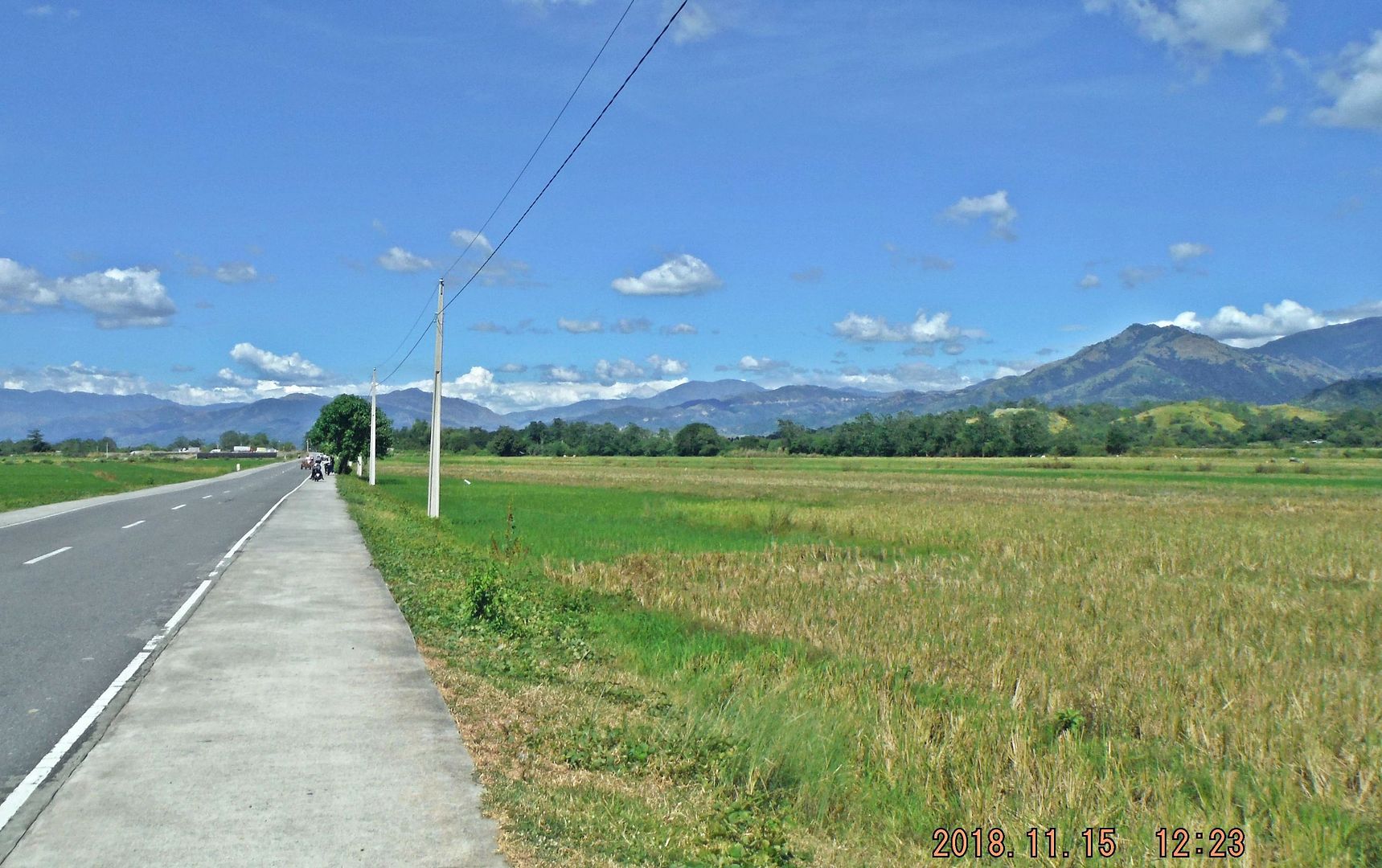 Z322. One of 7 images (in the album) of views from East Pangasinan from the Tayug to Umingan Road, they are from Left to Right. Major Robert B. Lapham established his HQ. in Barrio Calitlitan of the Umingan Municipality in 1942.A plaque is located in Umingan. 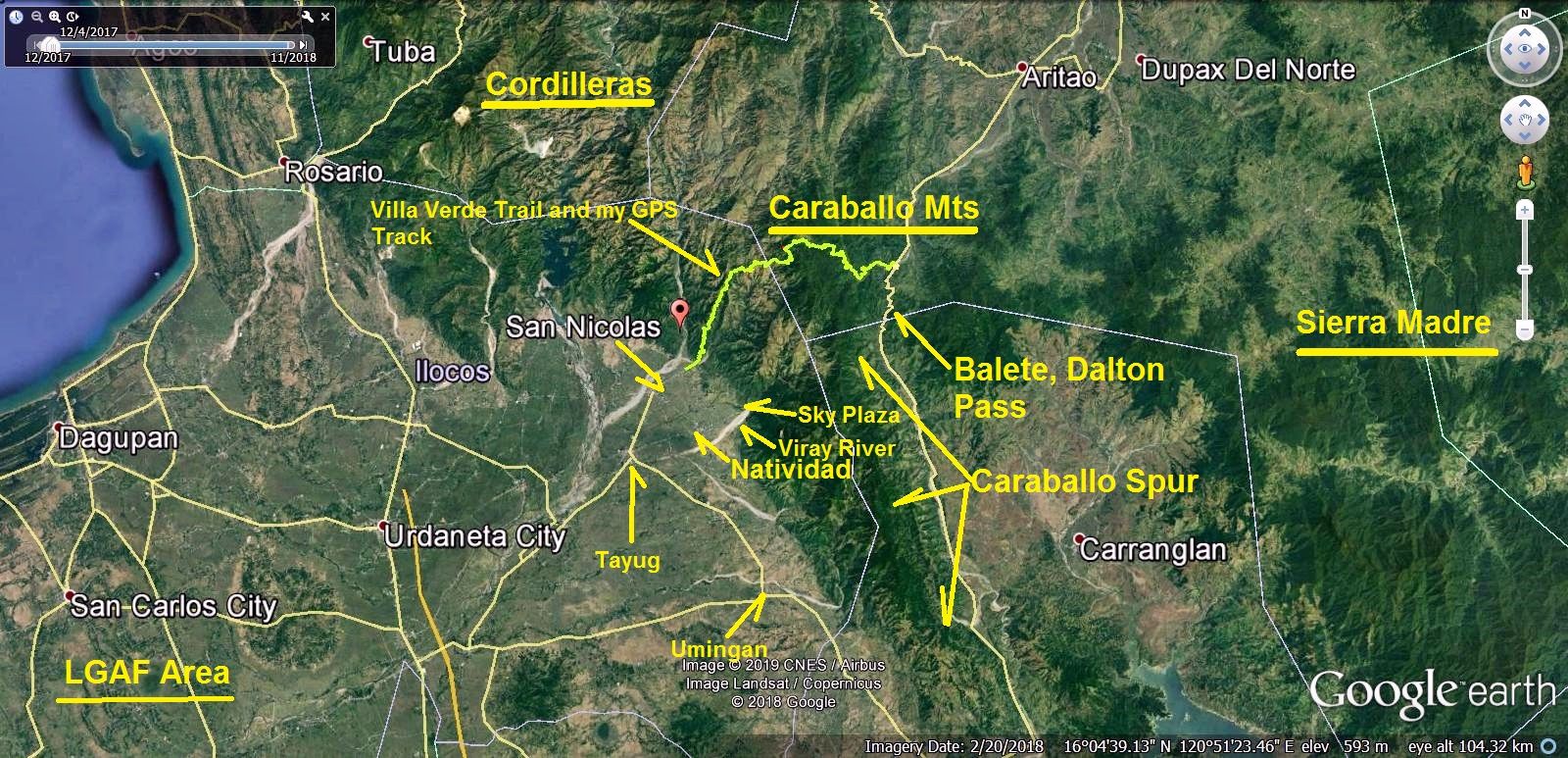 Z323. A Google Earth image of the Luzon Guerrilla Army Forces (LGAF) HQ Area. A plaque in Umingan says this: During WWII, so that democracy shall not perish in this particular part of the globe, on May 9, 1942 in the mountains within the vicinity of Barrio Calitlitan Col. Robert B. Lapham, then 1st Lt. 803rd M.P. U. S, Army organized the Luzon Guerrilla Army Forces (LGAF) which finally composed of 164 Guerilla Squadrons and units with a total strength of an Army Division and with area of operations covering Pangasinan, Nueva Ecija, Tarlac and Pampanga under his overall command.  Z324. One of 13 images (in the album) of my ride to Hill 357 which houses now the Sky Plaza, one drives thru Barrio Batchelor East, of the Natividad Municipality. Visiting this site is properly organized by the Natividad Municipality with an entrance and information desk. I chose this road because according the map thus would bring me closest to the foot hills of the Caraballo Mountain Spur where the LGAF had their HQ. 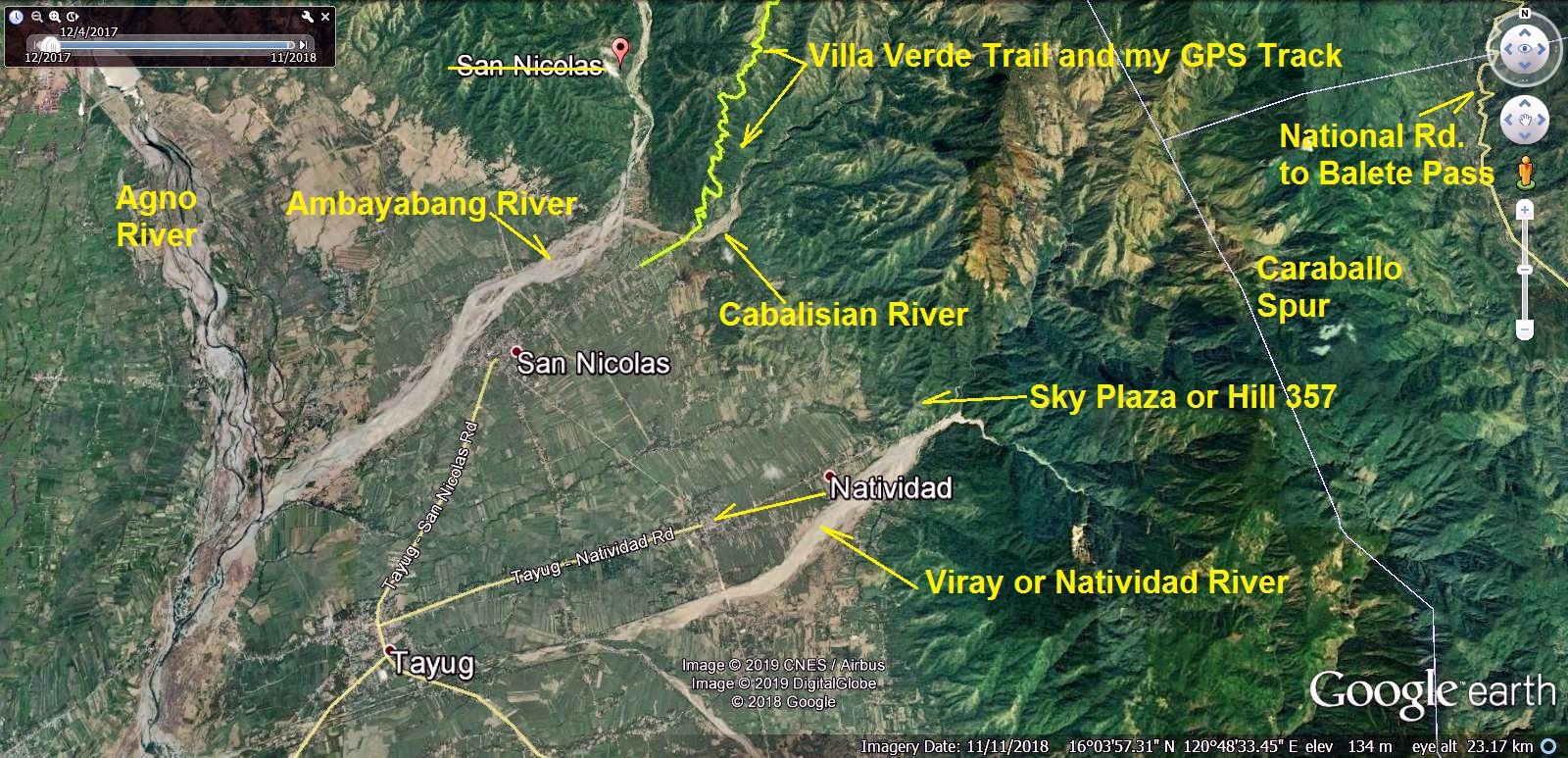 Z325. A Google Earth image of the Luzon Guerrilla Army Forces (LGAF) HQ Area; this shows you the area of Hill 357 which houses now the Sky Plaza. I hoped to get some vista shots (views) of the LGAF area of operation. 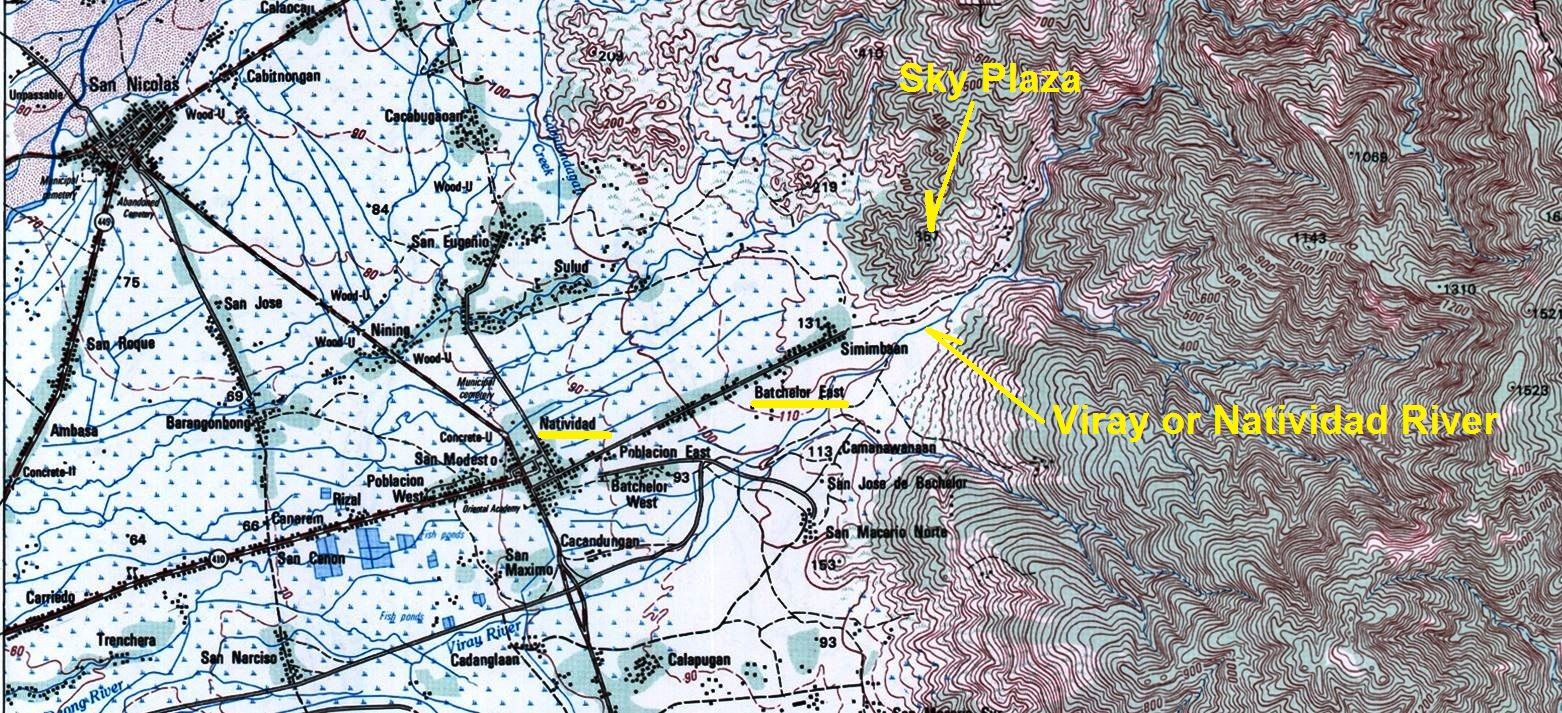 Z326. This is a section of an 1:50000 map that shows us clearly the area I visited on this drive to Hill 357 in the foot hills of the Caraballo Mountains Spur, the backdrop of the LGAF HQ in Umingan.  Z327. One of 13 images of my ride to Hill 357 which houses now the Sky Plaza, one drives thru Barrio Batchelor East, of the Natividad Municipality. Visiting this site, it is properly organized by the Natividad Municipality with an entrance and information desk. 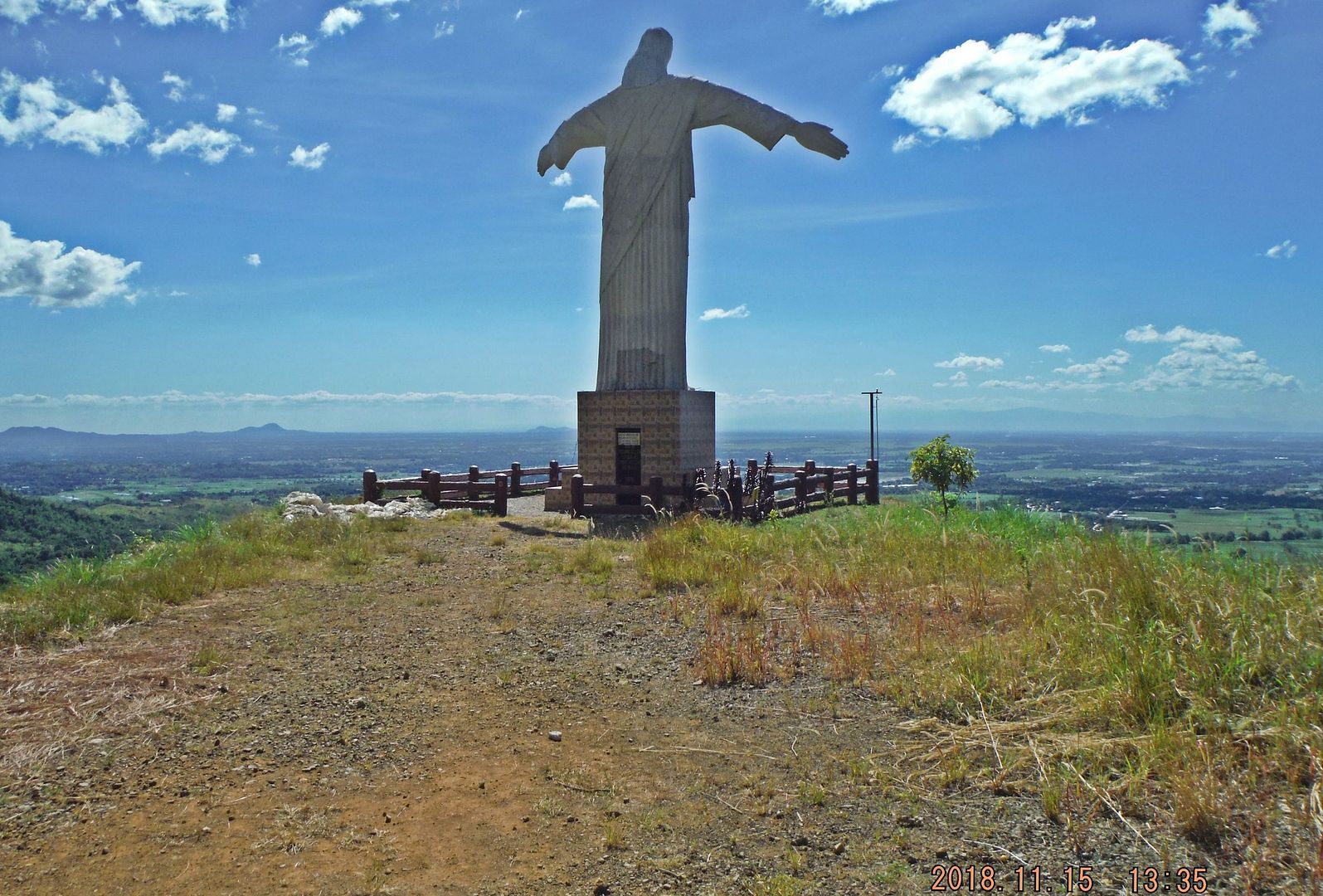 Z3228. One of 9 images of the Sky Plaza on Hill 357, part of the Natividad Municipality; one walks up many steps, on top is a Jesus stature and on the way up is a cross and a grotto. Here we have complete vista of Pangasinan, in the distance at right are the Zambales Mountains. The LGAF controlled this area on foot! 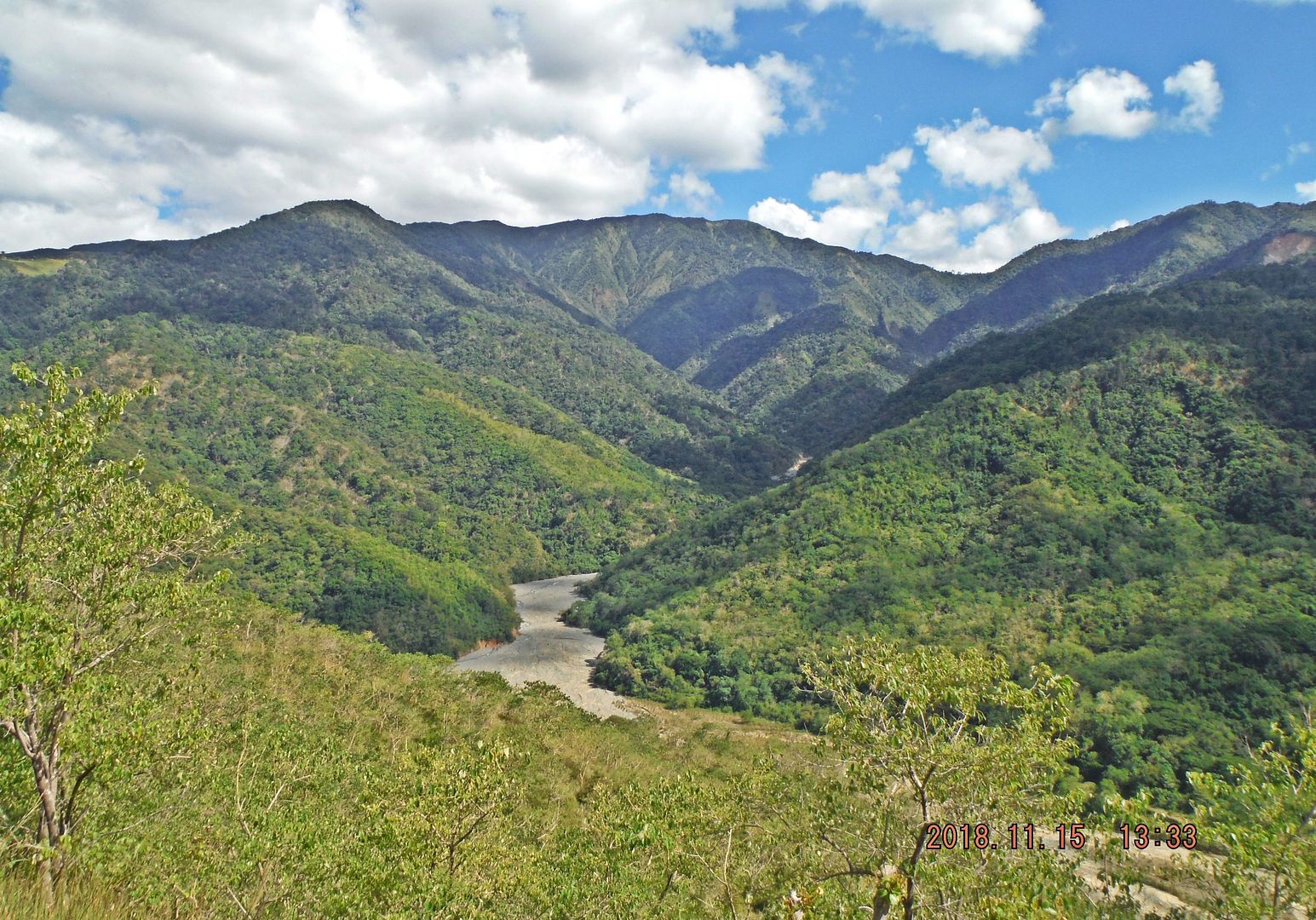 Z329. One of 15 images of the Sky Plaza on top of Hill 357; I was looking for this great vista of the LGAF operating area. Here they eliminated or chased off spies and collaborators and learned how to win the support and trust of civilians. This view gives you a good and close view of the Caraballo Mountains Spur, the backdrop of the LGAF HQ in Umingan. 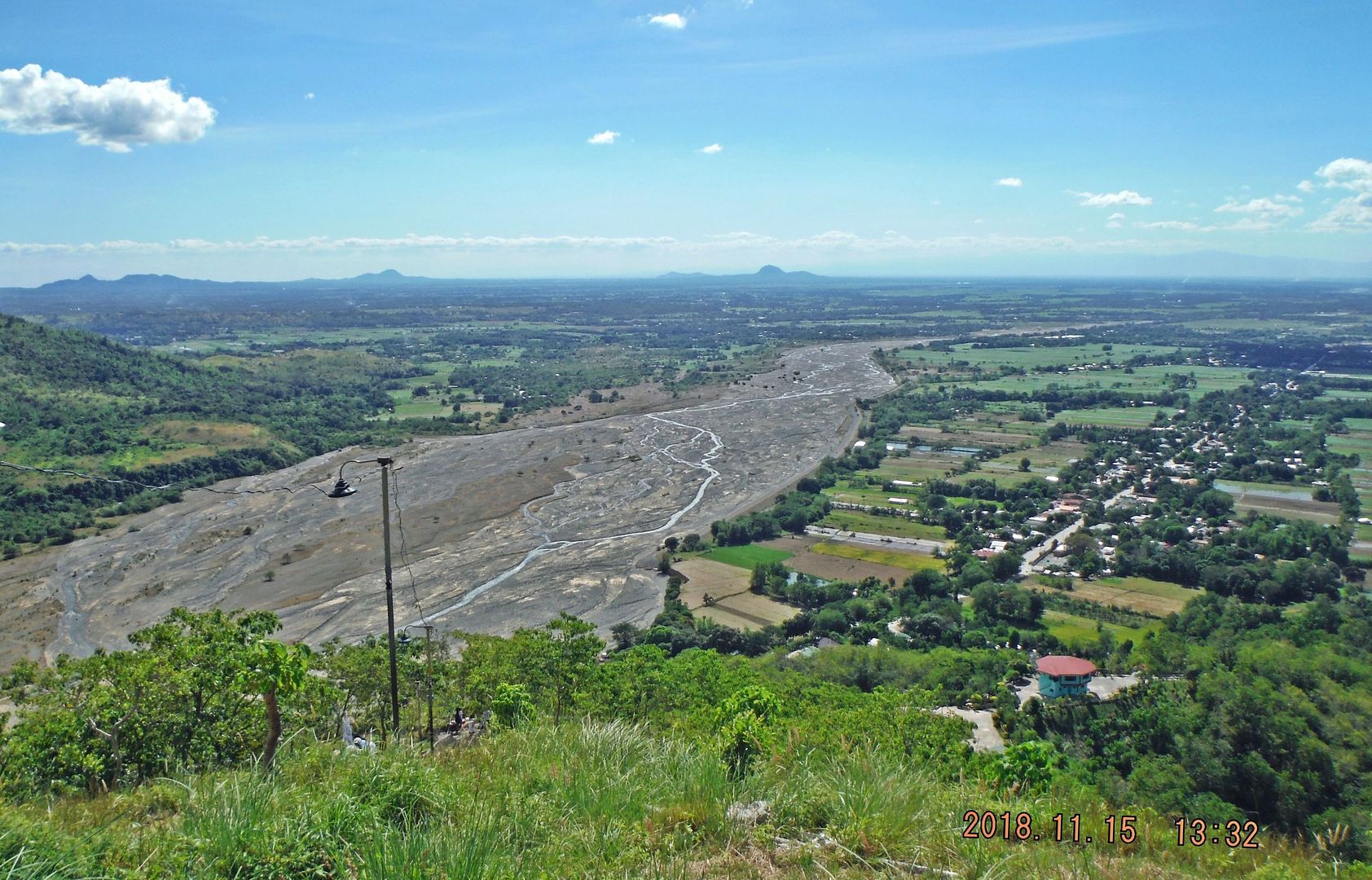 Z330. One of 15 images of the Sky Plaza on top of Hill 357; I was looking for this great vista of the LGAF operating area. Here they eliminated or chased off spies and collaborators and learned how to win the support and trust of civilians. This view gives you a good and close view of the lowlands of Pangasinan. Major Lapham preferred to operate here; because more people and resources were here. 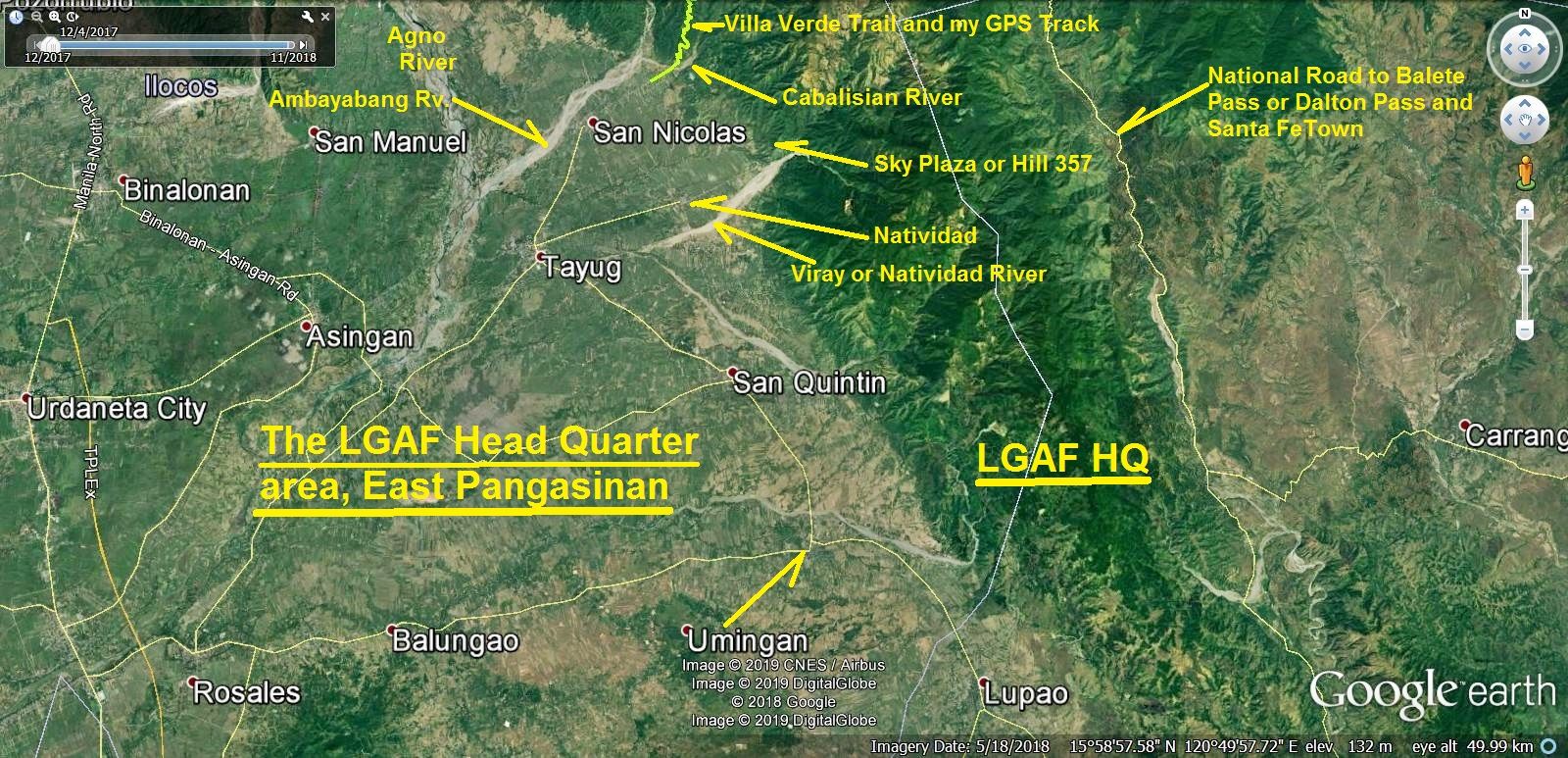 Z331. A Google Earth image of the Luzon Guerrilla Army Forces (LGAF) HQ Area; this shows you the area of Hill 357 which houses now the Sky Plaza. I hoped to get some vista shots (views) of the LGAF area of operation. 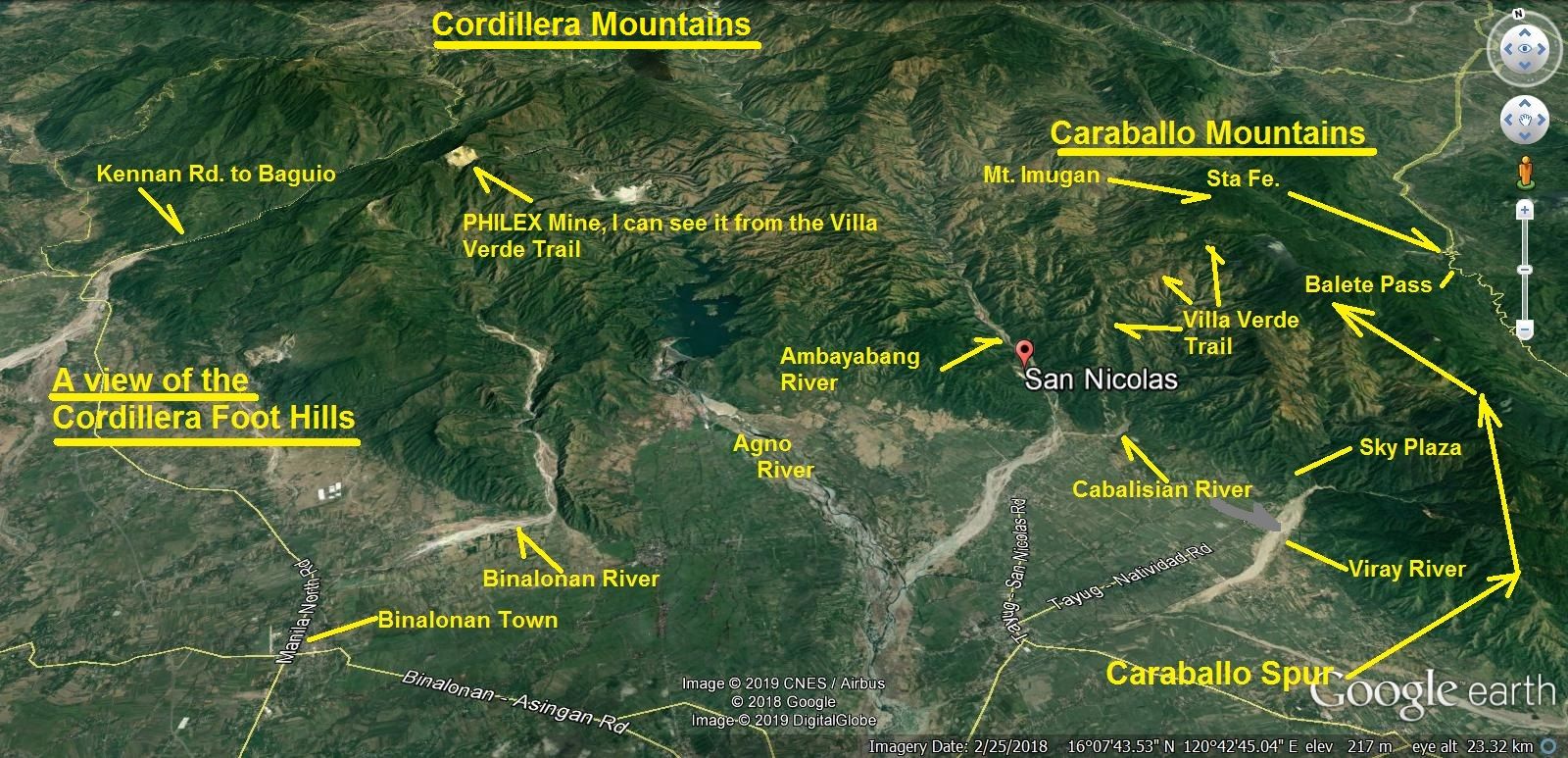 Z332. Thanks to this Google Earth image we have great shot at the south Cordillera Foot Hills; those were the north boundary of the LGAF operating area.  Z333. Villa Verde Trail. Major Lapham once had to retreat onto the Villa Verde trail to evade the Japanese who had a high price on his head. The Ambayabang River actually starts north of the Cabalisian River and flows first north, then curves to the west and then curves again and flows south into the Agno River. This picture (we are looking north) shows the watershed boundary of the two rivers and the Villa Verde Trail follows it to the east until it hits the Caraballo Spur. Then the Villa Verde Trail runs north along the west slopes of the Caraballo Spur until it enters the Salacsac Passes. If you are interested I established two albums with 55 images each about this subject: Uploaded to the Photobucket: app.photobucket.com/u/PI-Sailor/a/40623a97-ed3a-43b9-be9f-cdecd60a2043?field=TITLE&desc=ascUploaded to Facebook: www.facebook.com/karlwilhelm.welteke/media_set?set=a.10215449829912616&type=3&uploaded=55 |
|
|
|
Post by Karl Welteke on Oct 29, 2023 13:42:06 GMT 8
Luzon Guerrilla Army Forces (LGAF) in Umingan In Umingan, Pangasinan, the veterans of the LGAF established Memorial Marker and it says this, I deciphered it: During WWII, so that democracy shall not perish in this particular part of the globe, on May 9, 1942 in the mountains within the vicinity of Barrio Calitlitan Col. Robert B. Lapham, then 1st Lt. 803rd M.P. U. S, Army organized the Luzon Guerrilla Army Forces (LGAF) which finally composed of 164 Guerilla Squadrons and units with a total strength of an Army Division and with area of operations covering Pangasinan, Nueva Ecija, Tarlac and Pampanga under his overall command. On Feb. 3 1945 this Municipality was liberated by the joint forces of Squadron 269 LGAF under the command of Squadron Commander Major Antonio M. Hernandez and the 27th Infantry Regt., America’s Liberating Forces under the command of Lt. Col. Philip T. Lindeman from a very stiff resistance of the Japanese Imperial Army. -UVA- Umingan Veterans Association ---------------------------------------- This large and effective guerrilla organization contributed much to the liberation from the Japanese occupation. The LGAF established a regiment which directly fought with the 25th Division and broke thru the Balete Pass, later called Dalton Pass because as the Commanding Officer of the 25th Division got killed by a sniper. Other units fought with the 32nd Division and helped break thru the Salacsac Passes on the Villa Verde Trail. Another great contribution was the great team contribution the LGAF made in the successful execution of the Great Raid. This Marker was established at the Balete Pass/Dalton Pass to commemorate the LGAF contribution in the Liberation of the Philippines. 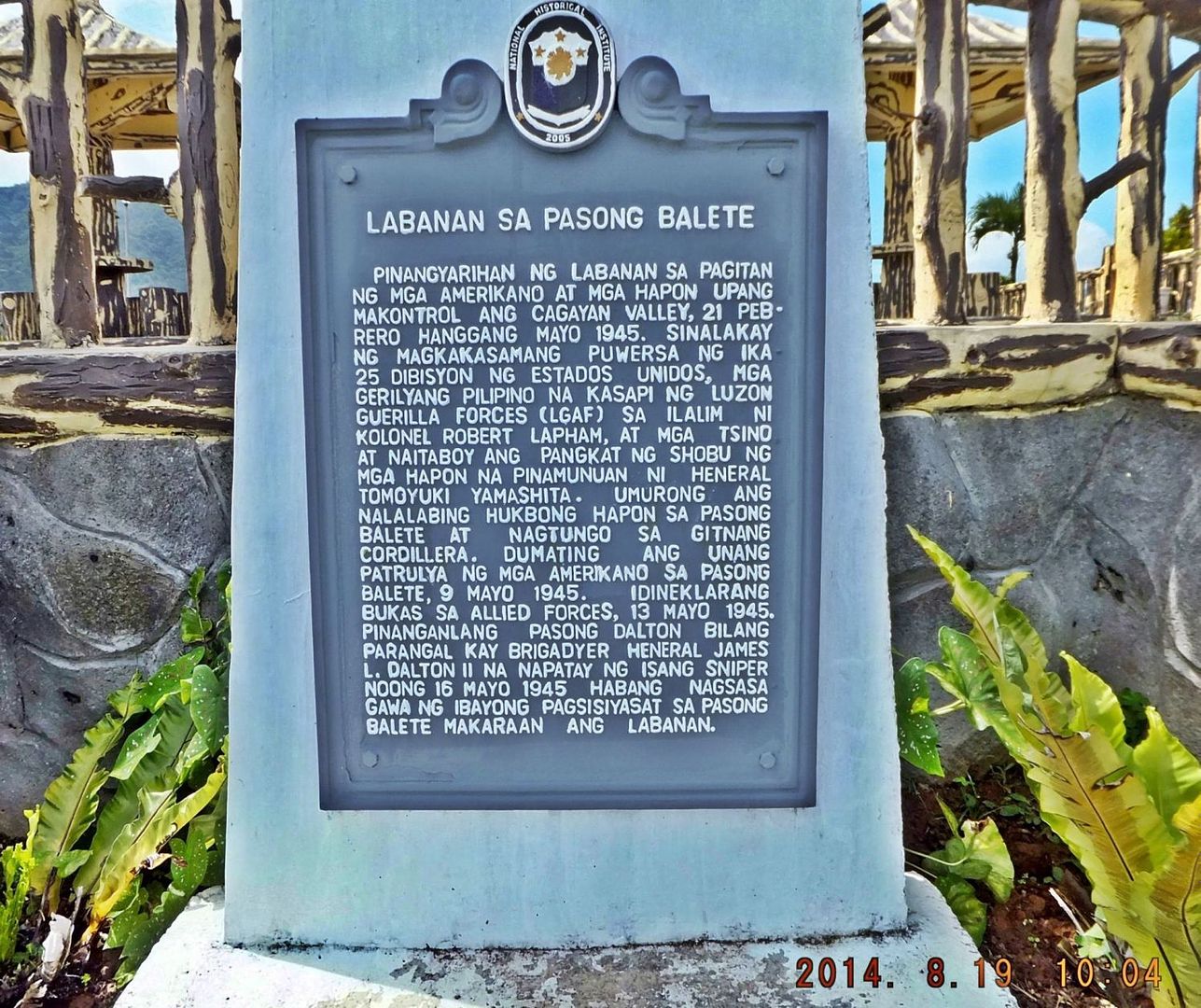 U097. The Liberation Marker at the Dalton Pass mentioning the LGAF. 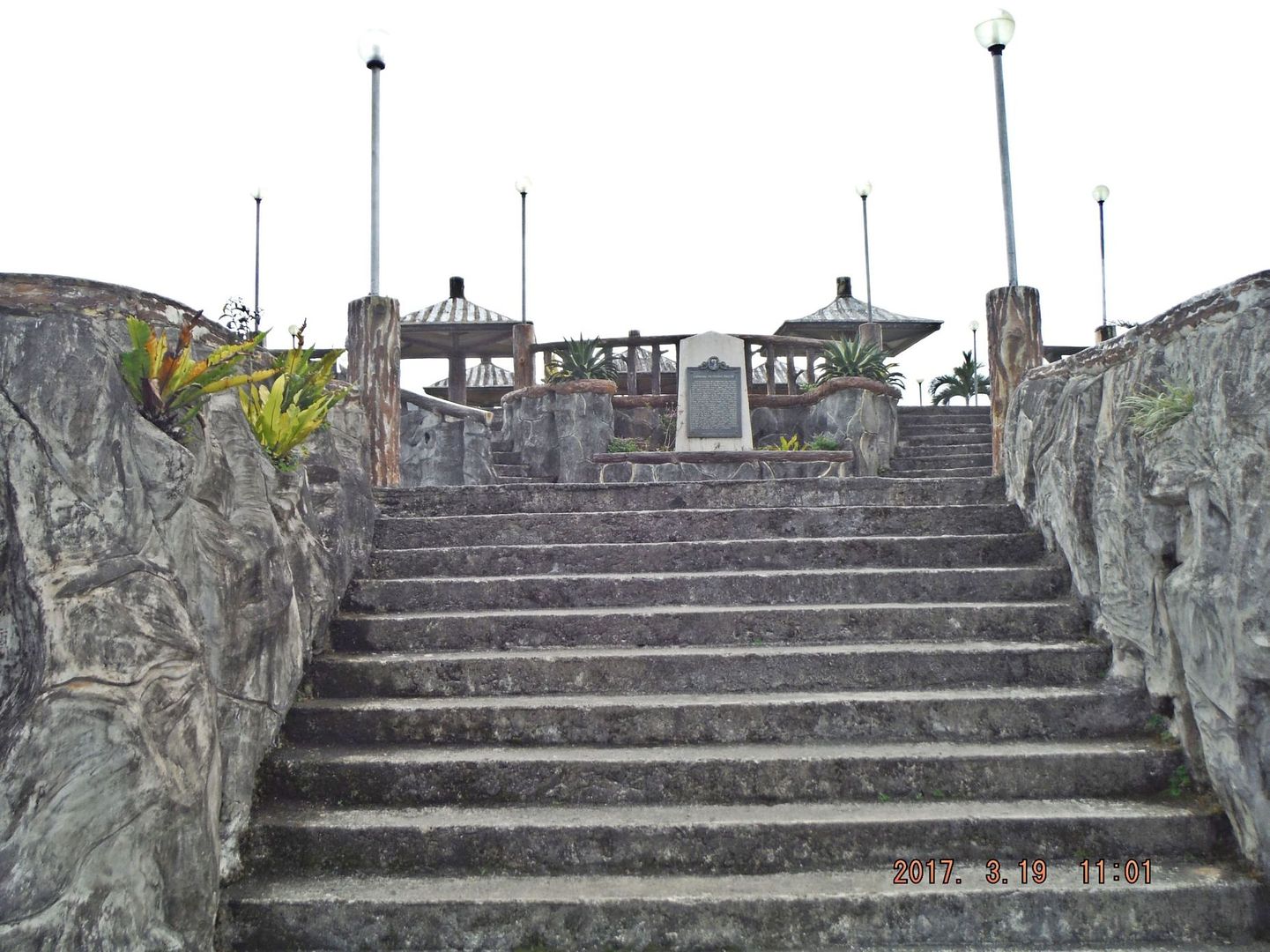 U098. The Liberation Marker at the Dalton Pass mentioning the LGAF is located at the very top at this historical Place. --------------------------------------------- Their heroic deeds have drawn me to Umingan several times. On the 4th of Oct. 2023 I tried to reach Barrio Calitlitan, part of Umingan where on May 9, 1942 in the mountains within the vicinity of Barrio Calitlitan Col. Robert B. Lapham, then 1st Lt. 803rd M.P. U. S, Army organized the Luzon Guerrilla Army Forces (LGAF) which finally composed of 164 Guerilla Squadrons and units with a total strength of an Army Division and with area of operations covering Pangasinan, Nueva Ecija, Tarlac and Pampanga under his overall command. I tried to go there with my car but it was too risky and I did not allow myself enough time. The new road was very narrow, a one lane road, and no shoulders only deep ditches. I have to give myself more time and make my approach on foot and start with a tricycle. 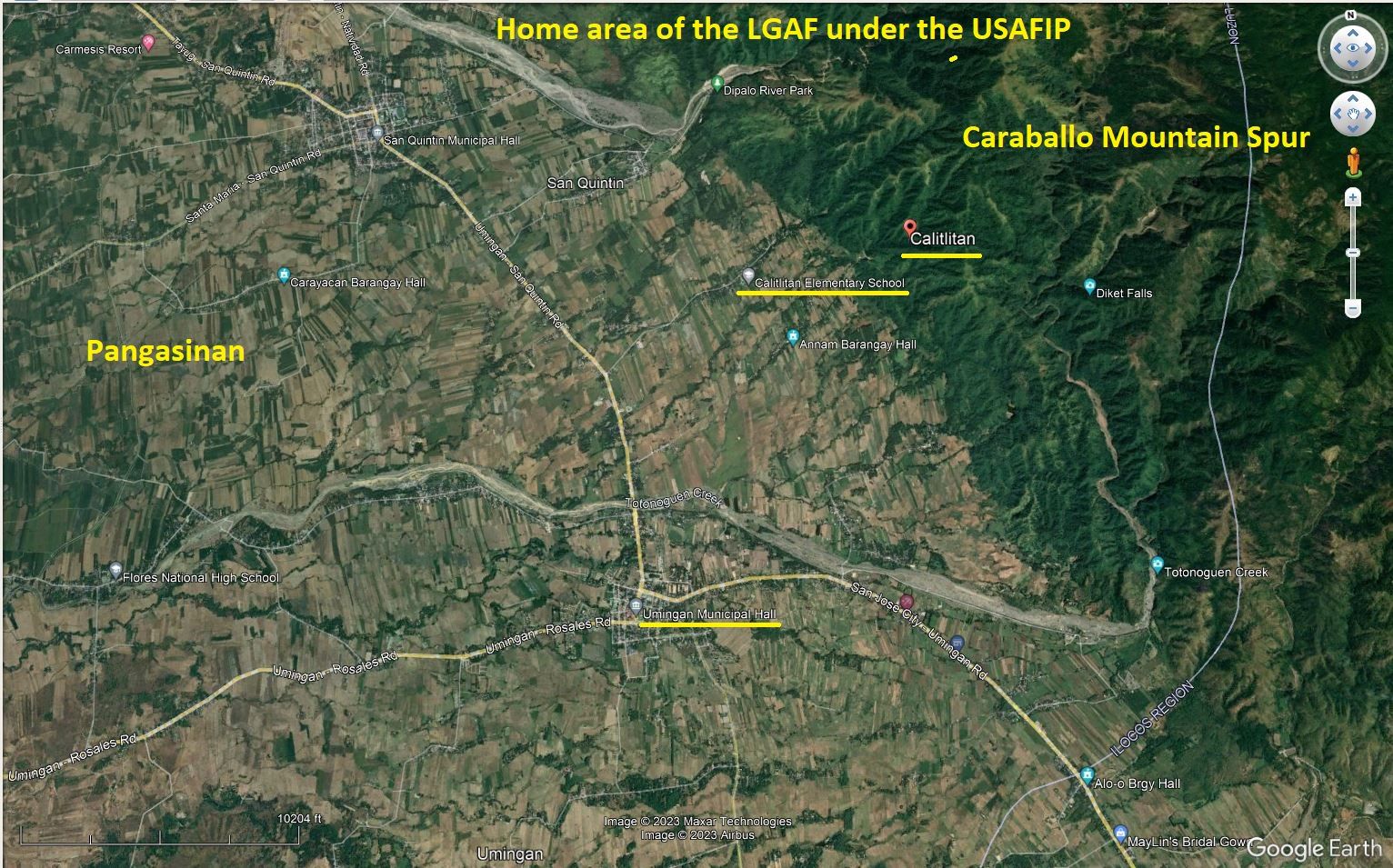 U099. A Google Earth image of Barrio Catlitlitan, part of the Umingan area in Pangasinan. |
|
|
|
Post by Karl Welteke on Oct 29, 2023 18:41:22 GMT 8
2023 Luzon Guerrilla Army Forces (LGAF) Marker in Umingan The veterans of WWII in this Guerrilla Force built a marker in their Commemoration in this town. I admire them, their history awoke my interest plus this historical place is with my reach. A webpage about this organization has been started here and I will contribute this visit to it. corregidor.proboards.com/thread/2177/guerrillas-wwii-central-luzonFirst I put these 37 images into this Photobucket. Uploaded to PhB, Memorials and Markers-any other, Philippine historical No2, app.photobucket.com/u/PI-Sailor/a/c401757f-c990-49bd-a804-e9d7aa1f6731?field=TITLE&desc=ascFor this forum presentation I chose these 10 images and these 10 images are also availabel in high resolution at this URL: Added this image (in high resolution) into this Flickr album, album is in the High resolution Collection: www.flickr.com/photos/44567569@N00/albums/72157700770241712 -#01 to #03 are images to indicated where Umingan Town is, where the LGAF Memorial Marker is and that I indentified to location of the plaques.  #01 image. 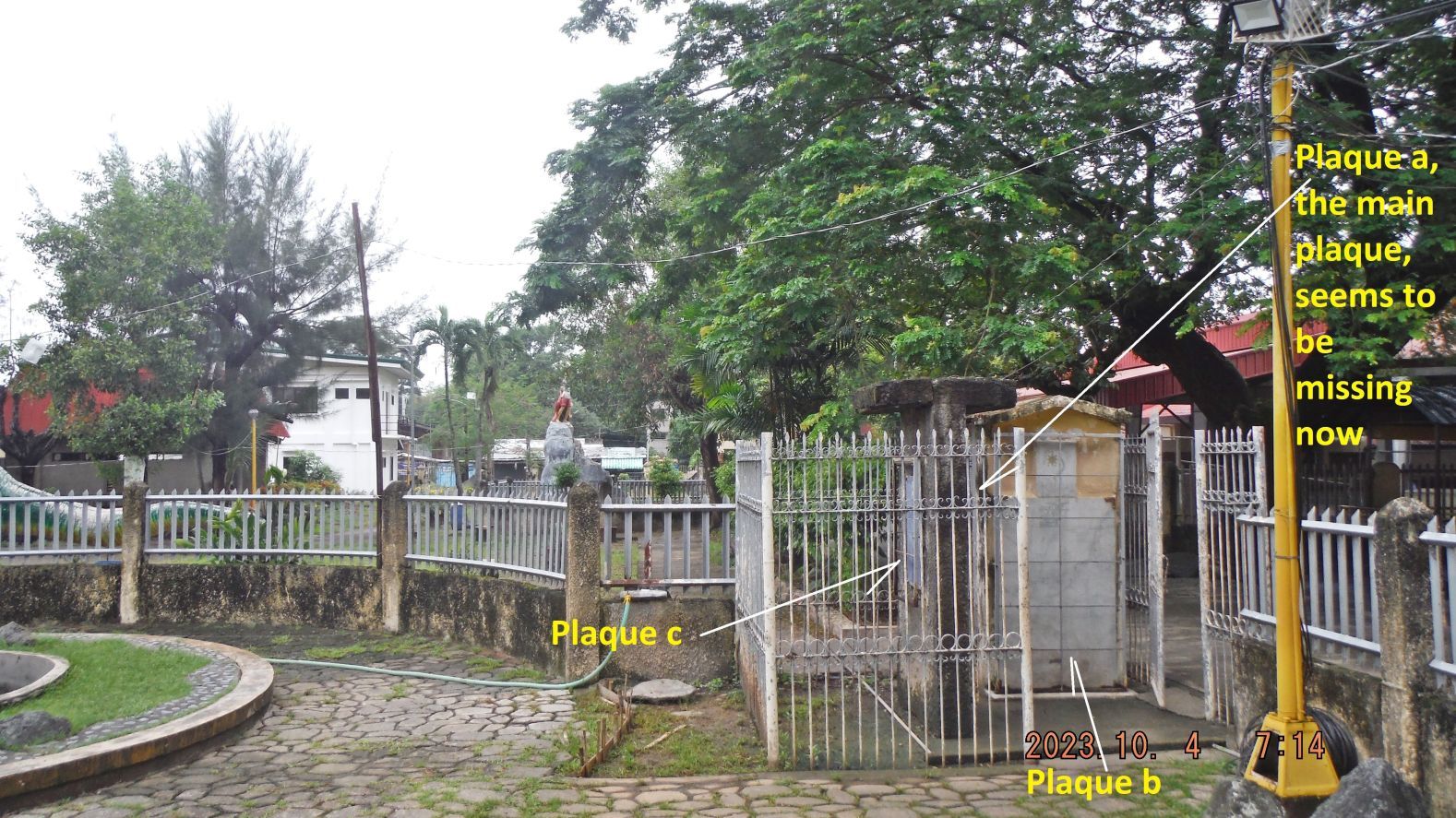 #02 image. 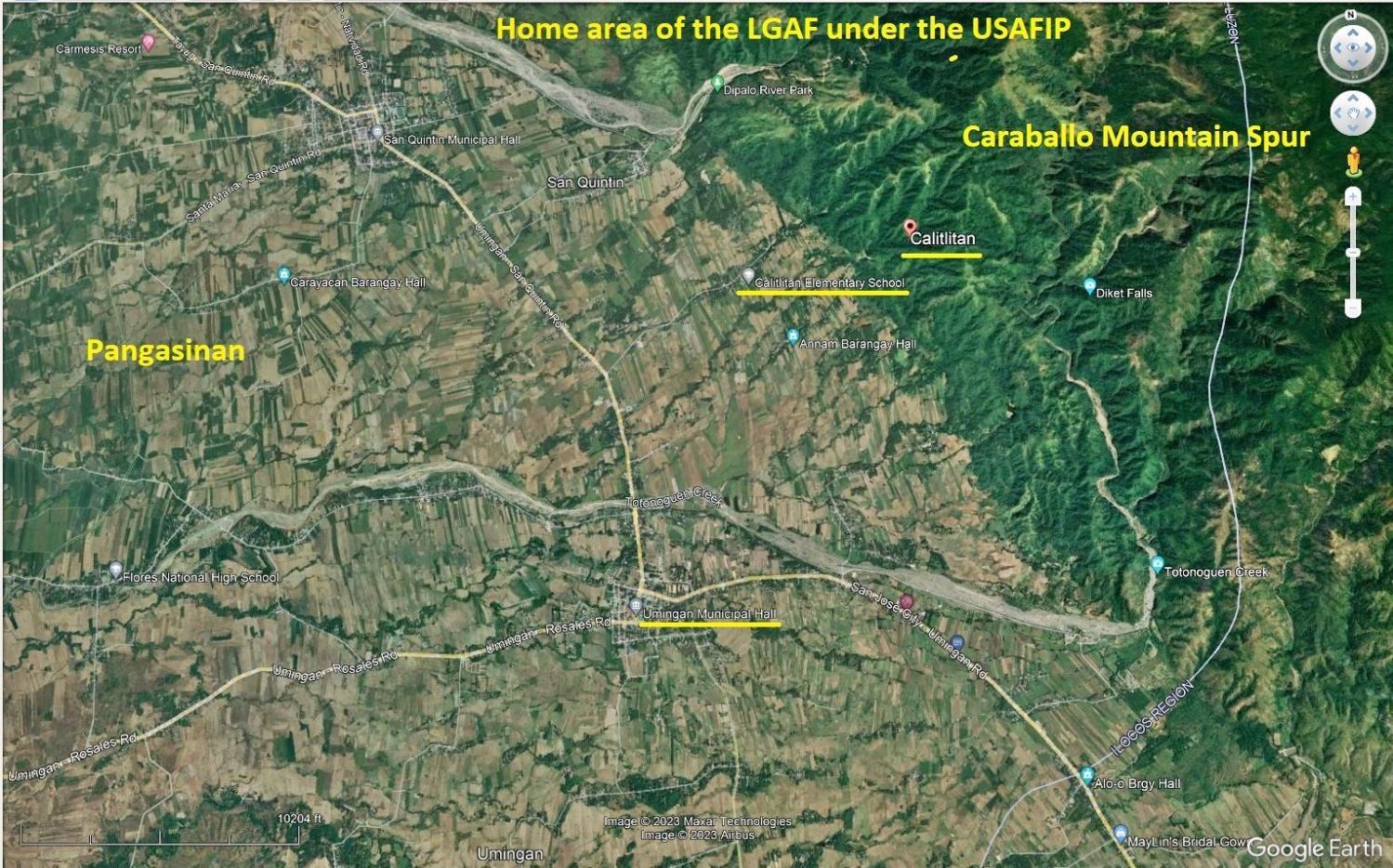 #03 image. ------------------------------------------------- -#04 to #11 are images of the patriotic park in Umingan, with markers of WWII, Andres Bonifacio and the LGAF Markers. 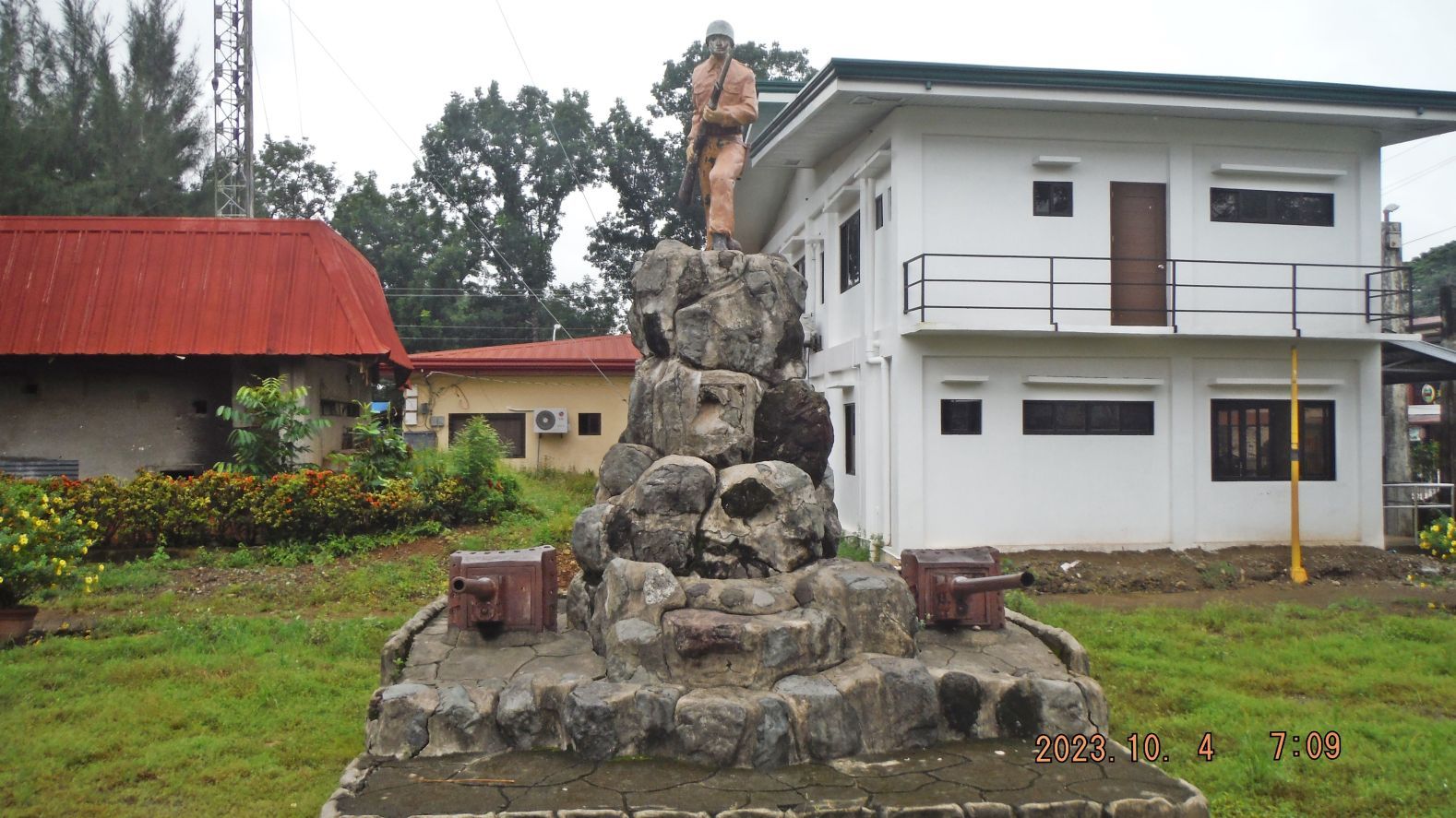 #08 image 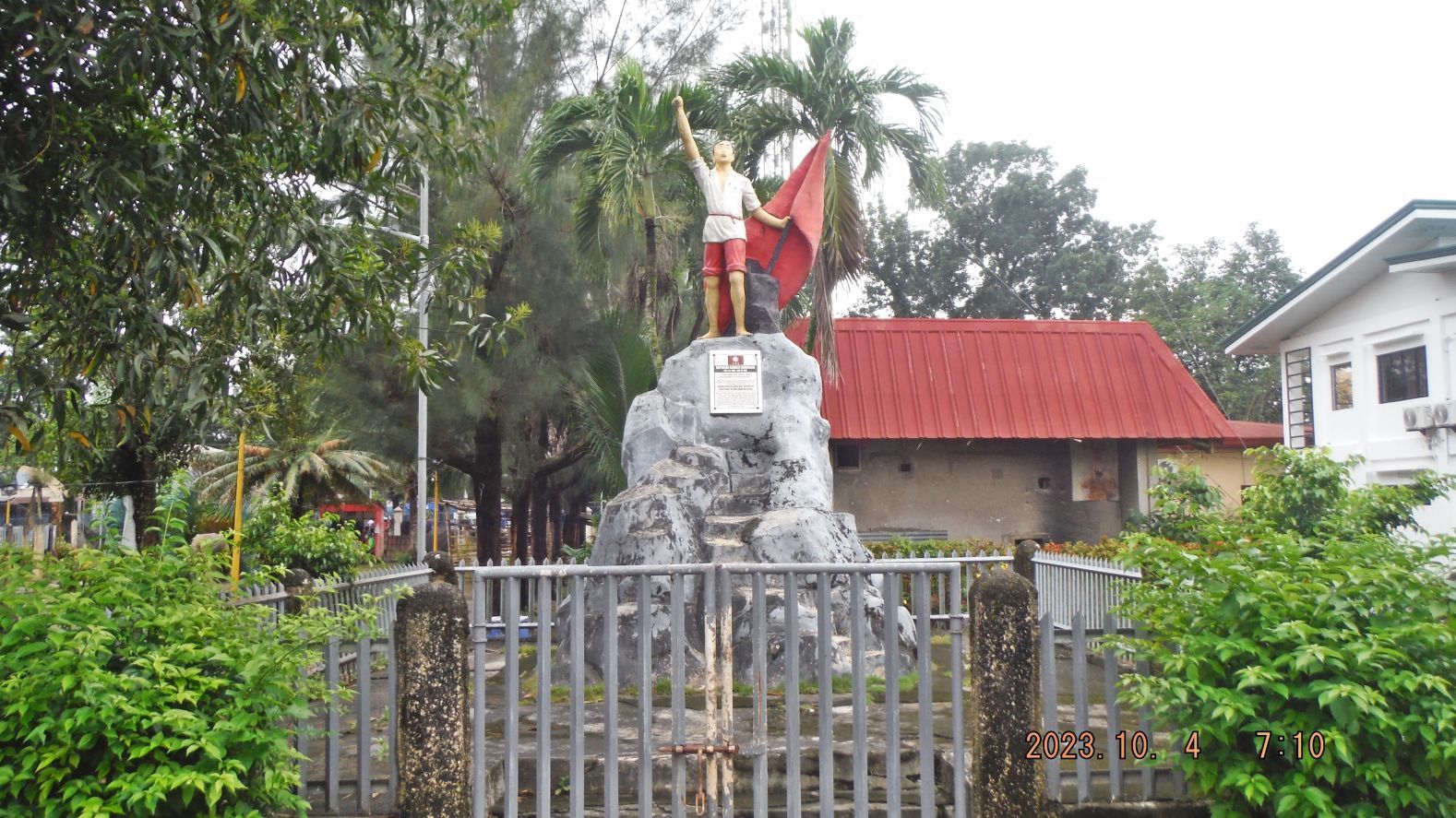 #11 image. ------------------------------------------------------- -#12 to #22 are images of the LGAF Memorial Marker; there was a total of 5 plaques in 2018. But now the Main Plaque is gone. Compare images #18 and #19; # 19 shows the main plaque in that 2018 image but in #18 image of 2023 the plaque is gone! 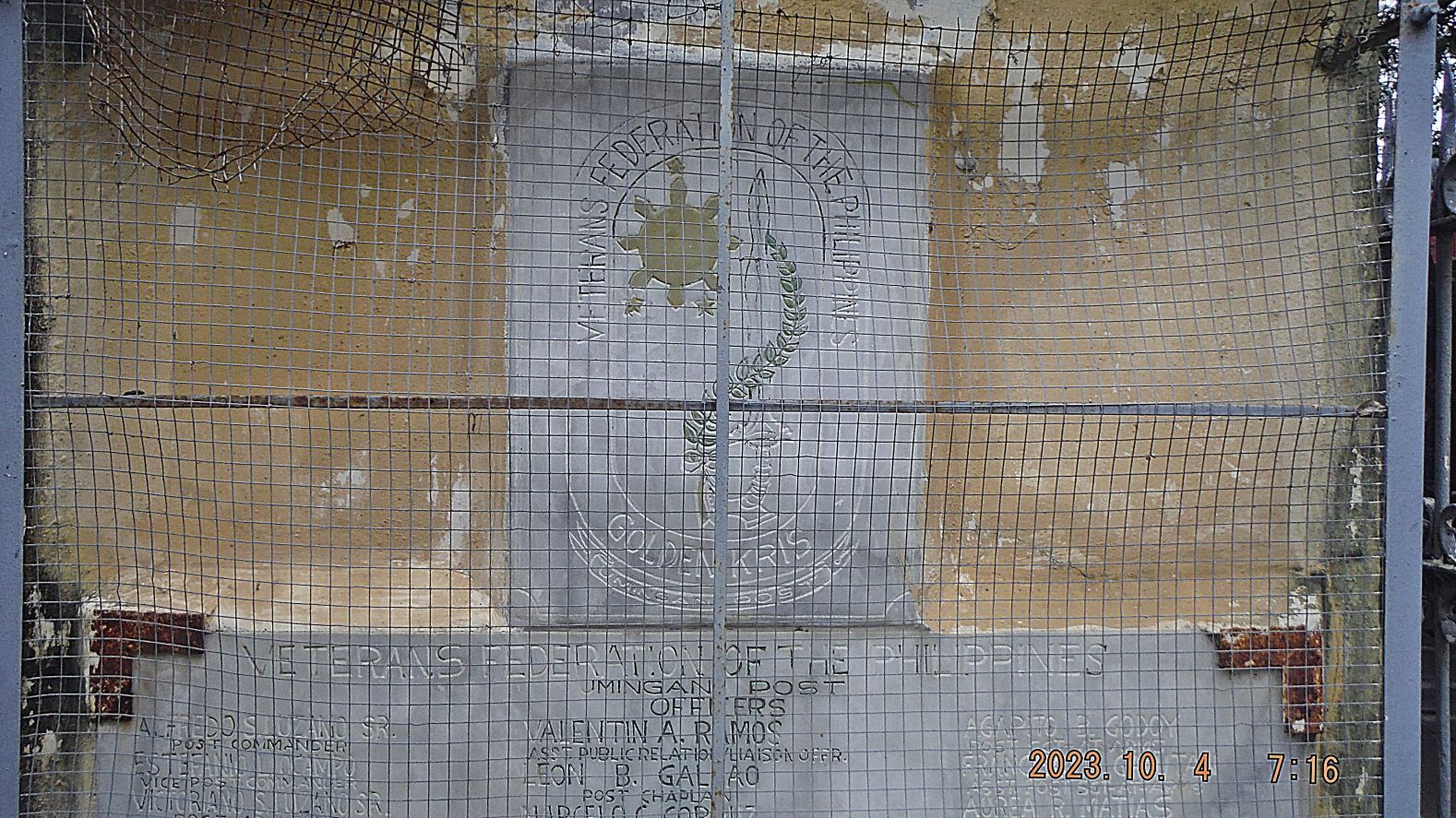 #16 image 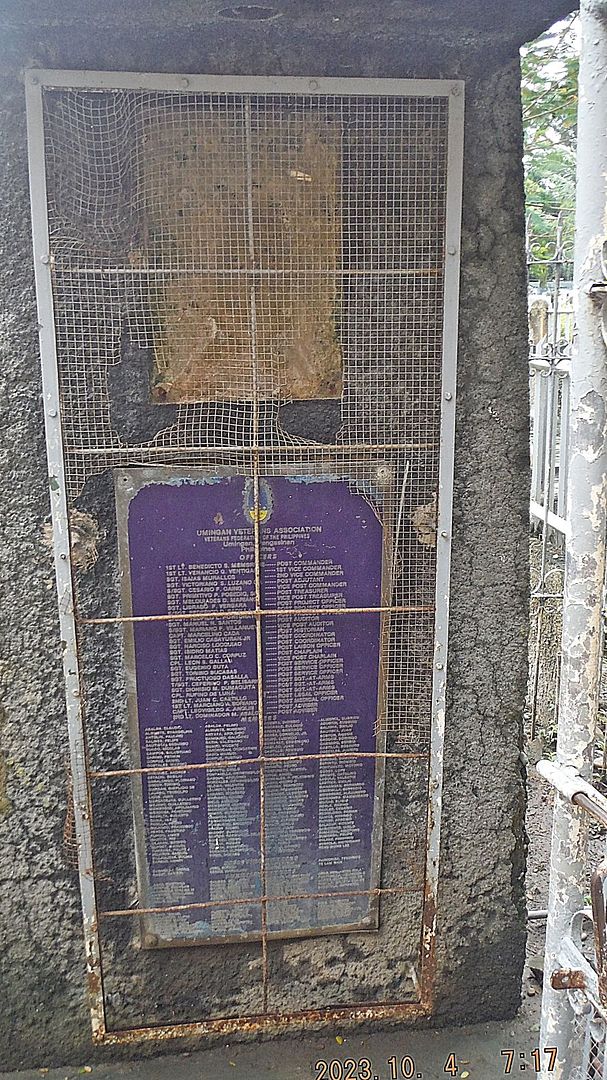 #18 image, the main plaque is gone!!!!  #21 image. ----------------------------------------------- 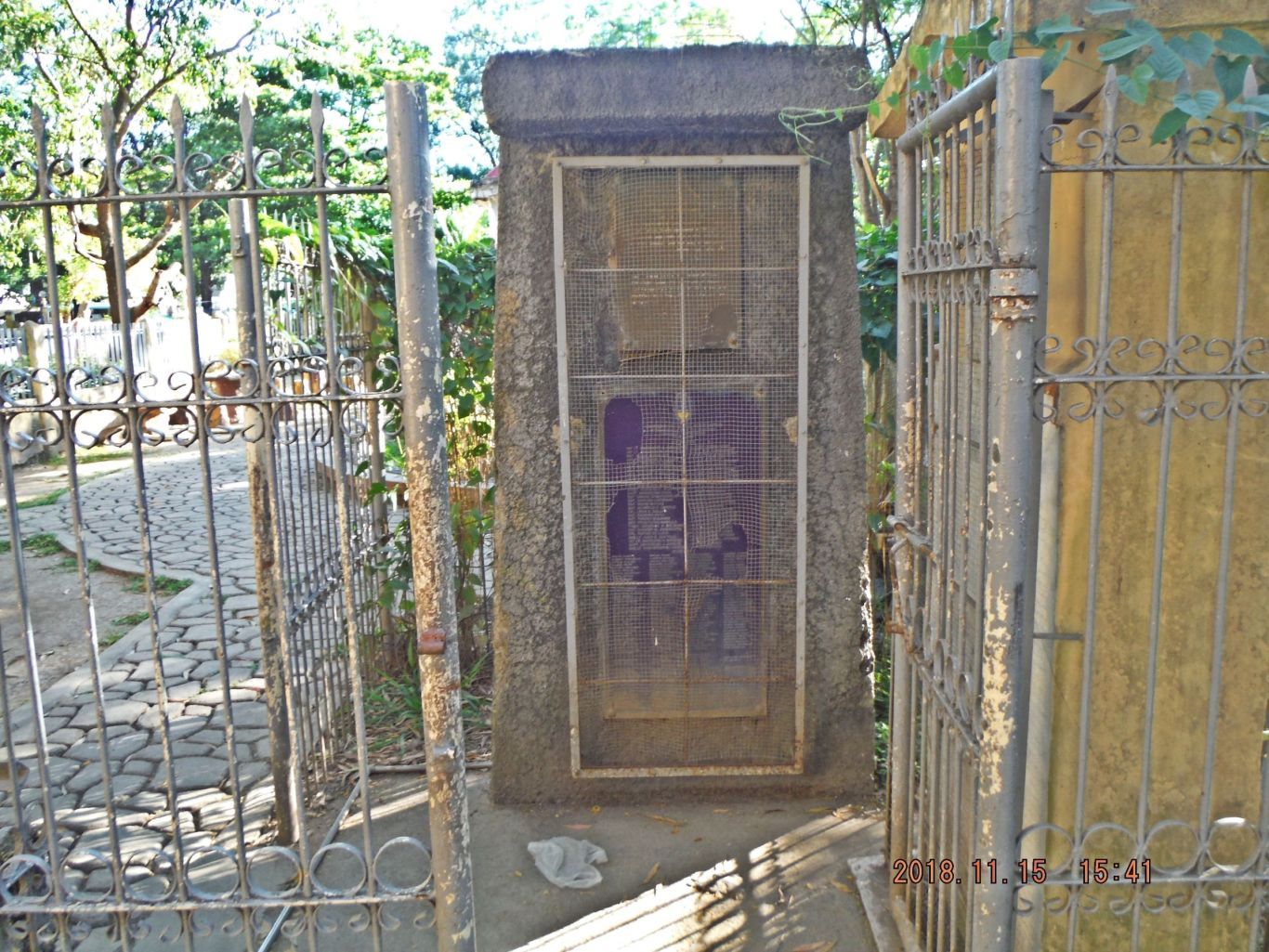 -#19 image, the LGAF Plaque in Umingan said this in 2018, I deciphered it: During WWII, so that democracy shall not perish in this particular part of the globe, on May 9, 1942 in the mountains within the vicinity of Barrio Calitlitan Col. Robert B. Lapham, then 1st Lt. 803rd M.P. U. S, Army organized the Luzon Guerrilla Army Forces (LGAF) which finally composed of 164 Guerilla Squadrons and units with a total strength of an Army Division and with area of operations covering Pangasinan, Nueva Ecija, Tarlac and Pampanga under his overall command. On Feb. 3 1945 this Municipality was liberated by the joint forces of Squadron 269 LGAF under the command of Squadron Commander Major Antonio M. Hernandez and the 27th Infantry Regt., America’s Liberating Forces under the command of Lt. Col. Philip T. Lindeman from a very stiff resistance of the Japanese Imperial Army. |
|
















































